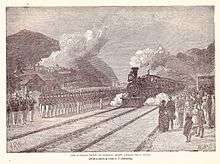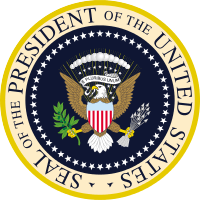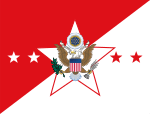Ulysses S. Grant
| General of the Army Ulysses S. Grant | |
|---|---|
 Grant during the mid-1870s | |
| 18th President of the United States | |
|
In office March 4, 1869 – March 4, 1877 | |
| Vice President |
|
| Preceded by | Andrew Johnson |
| Succeeded by | Rutherford B. Hayes |
| 6th Commanding General of the United States Army | |
|
In office March 9, 1864 – March 4, 1869 | |
| President | |
| Preceded by | Henry W. Halleck |
| Succeeded by | William Tecumseh Sherman |
| Personal details | |
| Born |
Hiram Ulysses Grant April 27, 1822 Point Pleasant, Ohio, U.S. |
| Died |
July 23, 1885 (aged 63) Wilton, New York, U.S. |
| Resting place |
General Grant National Memorial Manhattan, New York |
| Political party | |
| Spouse(s) | Julia Dent (m. 1848) |
| Children | Frederick, Ulysses Jr., Nellie, and Jesse |
| Alma mater | United States Military Academy |
| Occupation | soldier, politician |
| Religion | Nondenominational Protestant |
| Signature |
|
| Military service | |
| Allegiance |
|
| Service/branch |
Union Army |
| Years of service |
1839–1854 1861–1869 |
| Rank |
|
| Commands |
|
| Battles/wars |
Mexican–American War American Civil War |
| ||
|---|---|---|
|
President of the United States Post-Presidency |
||
Ulysses S. Grant (born Hiram Ulysses Grant; April 27, 1822 – July 23, 1885) was the 18th President of the United States (1869–77). As Commanding General of the United States Army (1864–69), Grant worked closely with President Abraham Lincoln to lead the Union Army to victory over the Confederacy in the American Civil War. He implemented Congressional Reconstruction, often at odds with Lincoln's successor, Andrew Johnson. Twice elected president, Grant led the Republicans in their effort to remove the vestiges of Confederate nationalism and slavery, protect African-American citizenship, and supported unbridled nationwide industrial expansionism during the Gilded Age.
Grant graduated in 1843 from the U.S. Military Academy at West Point, served in the Mexican–American War and initially retired in 1854. He struggled financially in civilian life. When the Civil War began in 1861, he rejoined the U.S. Army. In 1862, Grant took control of Kentucky and most of Tennessee, and led Union forces to victory in the Battle of Shiloh, earning a reputation as an aggressive commander. He incorporated displaced African American slaves into the Union war effort. In July 1863, after a series of coordinated battles, Grant defeated Confederate armies and seized Vicksburg, giving the Union control of the Mississippi River and dividing the Confederacy in two. After his victories in the Chattanooga Campaign, Lincoln promoted him to lieutenant-general and Commanding General of the United States Army in March 1864. Grant confronted Robert E. Lee in a series of bloody battles, trapping Lee's army in their defense of Richmond. Grant coordinated a series of devastating campaigns in other theaters. In April 1865, Lee surrendered to Grant at Appomattox, effectively ending the war. Historians have hailed Grant's military genius, and his strategies are featured in military history textbooks, but a minority contend that he won by brute force rather than superior strategy.[1]
After the Civil War, Grant led the army's supervision of Reconstruction in the former Confederate states. Elected president in 1868 and reelected in 1872, Grant stabilized the nation during the turbulent Reconstruction period, prosecuted the Ku Klux Klan, and enforced civil and voting rights laws using the army and the Department of Justice. He used the army to build the Republican Party in the South, based on black voters, Northern newcomers ("carpetbaggers"), and native Southern white supporters ("scalawags"). After the disenfranchisement of some former Confederates, Republicans gained majorities and African Americans were elected to Congress and high state offices. In his second term, the Republican coalitions in the South splintered and were defeated one by one as redeemers (conservative whites) regained control using coercion and violence. Grant's Indian peace policy initially reduced frontier violence, but is best known for the Great Sioux War of 1876, where George Custer and his regiment were killed at the Battle of the Little Bighorn. Grant responded to charges of corruption in executive offices more than any other 19th Century president. He appointed the first Civil Service Commission and signed legislation ending the corrupt moiety system.
In foreign policy, Grant sought to increase American trade and influence, while remaining at peace with the world. His administration successfully resolved the Alabama Claims by the Treaty of Washington with Great Britain, ending wartime tensions. Grant avoided war with Spain over the Virginius Affair, but Congress rejected his attempted annexation of the Dominican Republic. In trade policy, Grant's administration implemented a gold standard and sought to strengthen the dollar. Corruption charges escalated during his second term, while his response to the Panic of 1873 proved ineffective nationally in halting the five-year industrial depression that produced high unemployment, low prices, low profits, and bankruptcies. Grant left office in 1877 and embarked on a two-year world tour which greatly helped to establish the United States' presence abroad and captured the nation's attention.
In 1880, Grant was unsuccessful in obtaining a Republican presidential nomination for a third term. Facing severe investment reversals and dying of throat cancer, he completed his memoirs, which proved to be a major literary work and financial success. His death in 1885 prompted an outpouring in support of national unity. Historical assessment of Grant's legacy has varied considerably over the years. Early historical evaluations were negative about Grant's presidency, often focusing on the corruption charges against his associates. This trend began to change in the later 20th century. Scholars in general rank his presidency below the average, but modern research, in part focusing on civil rights, evaluates his administration more positively.
Early life

Hiram Ulysses Grant was born in Point Pleasant, Ohio, on April 27, 1822, to Jesse Root Grant, a tanner, and Hannah (née Simpson) Grant. His ancestors Matthew and Priscilla Grant arrived aboard the Mary and John at Massachusetts Bay Colony in 1630.[2] Grant's great-grandfather fought in the French and Indian War, and his grandfather served in the American Revolution at Bunker Hill.[3] Grant's father was a Whig Party supporter with abolitionist sentiments.[4] In 1823, the family moved to the village of Georgetown in Brown County, Ohio, where five more siblings were born: Simpson, Clara, Orvil, Jennie, and Mary.[5] Young Grant regularly attended public schools and later was enrolled in private schools.[6] While disliking the tannery, he chose work on his father's farm.[7] Unlike his siblings, Grant was not forced to attend church by his Methodist parents;[lower-alpha 1][8] for the rest of his life, he prayed privately and never officially joined any denomination.[9] Observers, including his own son, thought he was an agnostic.[8] In his youth, Grant developed an unusual ability to work with and control horses. As a general he rode the strongest and most challenging horse available, and was sometimes injured in riding.[10] In the winter of 1836–1837, Grant was a student at Maysville Seminary joining the Philomathean Society.[11]
Early military career and personal life

West Point and first assignment
When a cadet opening became available in March 1839, Congressman Thomas L. Hamer nominated the 16-year-old Grant to the United States Military Academy (USMA) at West Point, New York.[12] Grant entered the school on the Hudson River in May, and would be trained there for next four years.[13] Hamer mistakenly wrote down the name as "Ulysses S. Grant of Ohio", and this became his adopted name.[lower-alpha 2][14] His nickname became "Sam" among army colleagues at the academy since the initials "U.S." also stood for "Uncle Sam". As he later recalled it, "a military life had no charms for me"; he was lax in his studies, but he achieved above-average grades in mathematics and geology.[15] Quiet by nature, he established a few intimate friends, including Frederick Tracy Dent and Rufus Ingalls.[16] Grant developed a reputation as a fearless and expert horseman known as a horse whisperer, setting an equestrian high-jump record that stood for almost 25 years.[17] He also studied under Romantic artist Robert Walter Weir and produced nine surviving artworks. He graduated in 1843, ranking 21st in a class of 39. Glad to leave the academy, his plan was to resign his commission after his four-year term of duty.[18] Despite his excellent horsemanship, he was not assigned to the cavalry (assignments were determined by class rank, not aptitude), but to the 4th Infantry Regiment. He was made regimental quartermaster, managing supplies and equipment, with the rank of brevet second lieutenant.[19]
Grant's first assignment after graduation took him to the Jefferson Barracks near St. Louis, Missouri.[20] Commanded by Colonel Stephen W. Kearny, the Barracks was the nation's largest military base in the west.[21] Grant was happy with his new commander, but looked forward to the end of his military service and a possible teaching career.[22] He spent some of his time in Missouri visiting the family of his West Point classmate, Frederick Tracy Dent; he became engaged to Dent's sister, Julia, in 1844.[22] Four years later they married on August 22, 1848.[23] Over time, they had four children: Frederick, Ulysses Jr. ("Buck"), Ellen ("Nellie"), and Jesse.[24]
Mexican American War
Amid rising tensions with Mexico following the United States' annexation of Texas, President John Tyler ordered Grant's unit to Louisiana as part of the Army of Observation under Major General Zachary Taylor.[25] When the Mexican–American War broke out, President James K. Polk directed the U.S. Army to invade Mexico in 1846.[26] Although a quartermaster, Grant led a cavalry charge at the Battle of Resaca de la Palma.[27] At Monterrey he demonstrated his equestrian ability, by volunteering to carry a dispatch through sniper-lined streets while hanging off the side of his horse, keeping the animal between him and the enemy.[28] Polk, wary of Taylor's growing popularity, divided his forces, sending some troops (including Grant's unit) to form a new army under Major General Winfield Scott.[29] Traveling with a naval fleet, Scott's army landed at Veracruz and advanced toward Mexico City.[30] The army met the Mexican forces at the battles of Molino del Rey and Chapultepec outside Mexico City.[31] Grant was a quartermaster in charge of supplies and did not have a combat role, but he yearned for one and finally was allowed to take part in dangerous missions.[32] At San Cosmé, men under Grant's direction dragged a disassembled howitzer into a church steeple, reassembled it, and bombarded nearby Mexican troops.[31] His bravery and initiative earned him brevet promotions; he became a temporary captain while his permanent rank was lieutenant.[33] On September 14, 1847, Scott's army, including Grant, marched into the city, and the Mexicans agreed to peace soon afterward.[34]
During this war Grant studied the tactics and strategies of Scott and others, often second guessing their moves beforehand.[35] In his Memoirs, he wrote that this is how he learned about military leadership, and in retrospect identified his leadership style with Taylor's. Even so, he believed that the Mexican War was wrongful and that the territorial gains from the war were designed to expand slavery. Grant reflected in 1883, "I was bitterly opposed to the measure, and to this day, regard the war, which resulted, as one of the most unjust ever waged by a stronger against a weaker nation." He opined that the Civil War was punishment inflicted on the nation for its aggression in Mexico.[36]
Pacific west and resignation
Grant's mandatory service expired during the war, but he chose to remain a soldier. Grant's first post-war assignments took him and Julia to Detroit and then to Sackets Harbor, New York.[37] In 1852, Grant was ordered to the Pacific Northwest; the army was stationed there to keep peace between settlers and Indians after the Cayuse War, and to protect the West Coast. Julia, who was eight months pregnant with Ulysses Jr., did not accompany him.[38] While traveling overland through Panama, an outbreak of cholera among his fellow travelers caused 150 fatalities; Grant arranged makeshift transportation and hospital facilities to care for the sick.[39] Grant debarked in San Francisco during the height of the California Gold Rush.[38][40] His next assignment sent him north to Fort Vancouver in the Oregon Territory (subsequently Washington Territory in March 1853). To supplement a military salary which was inadequate to support his family, Grant tried and failed at several business ventures, confirming Jesse Grant's belief that his son had no head for business.[41] Promoted to captain in the summer of 1853, Grant was assigned in February 1854 to command Company F, 4th Infantry, at Fort Humboldt in California.[42] He was unhappy being separated from his family, and rumors circulated that he was drinking to excess. The commanding officer at Fort Humboldt, Lieutenant Colonel Robert C. Buchanan, received reports that Grant became intoxicated off-duty while seated at the pay officer's table. In lieu of a court-martial, Buchanan gave Grant an ultimatum to resign; he did so, effective July 31, 1854, without explanation.[43] The War Department stated on his record, "Nothing stands against his good name."[44] Historians overwhelmingly agree that his drunkenness at the time was a fact, though there are no eyewitness reports extant.[45] After Grant's retirement, rumors persisted in the regular army of his drinking.[45] Years later, he said, "the vice of intemperance (drunkenness) had not a little to do with my decision to resign."[46] Grant returned to St. Louis, uncertain about his future, but reunited with his family.[47]
Civilian struggles and politics

At age 32, with no civilian vocation, Grant struggled through seven financially lean years. His father initially offered him a place in the Galena, Illinois, branch of the family's tannery and leather goods business, on condition that Julia and the children stay with her parents in Missouri or with the Grants in Kentucky. Ulysses and Julia opposed another separation and declined the offer.[48] In 1855, Grant farmed on his brother-in-law's property near St. Louis, using slaves owned by Julia's father.[48] The farm was not successful and to earn money he sold firewood on St. Louis street corners.[49] The next year, the Grants moved to land on Julia's father's farm, and built a home Grant called "Hardscrabble".[48] Julia hated the rustic house, which she described as an "unattractive cabin".[48] In 1857, Grant acquired a slave, a thirty-five-year-old man named William Jones, from his father-in-law.[50] The Panic of 1857 devastated farmers, including Grant, who was forced to rent out Hardscrabble the following year.[51]
Having met with no success farming, the Grants left the farm when their fourth and final child was born in 1858. The following year in 1859 Grant freed his only slave Jones, who was 35 years old and worth about $1,500, instead of selling him at a time when Grant desperately needed money.[50][52] For the next year, the family took a small house in St. Louis where he worked with Julia's cousin Harry Boggs as a bill collector, again without success.[53] In 1860, Jesse offered him the job in Galena without conditions, and Grant accepted. The leather shop, "Grant & Perkins", sold harnesses, saddles, and other leather goods, and purchased hides from farmers in the prosperous Galena area. Grant and family moved to a rental house that year.[54]
After Grant had retired from the military, many considered him allied politically to Julia's father, Frederick Dent, a prominent Missouri Democrat.[55] In the 1856 election, Grant cast his first presidential vote for the Democrat, James Buchanan, later saying he was really voting against John C. Frémont, the first Republican candidate, over concern that Frémont's anti-slavery position would motivate southern states to secede.[56] In 1859, Grant's vote for Buchanan and his political affiliation to his father-in-law cost him an appointment to become county engineer.[55] Grant's own father in Illinois, Jesse, was an outspoken Republican in Galena.[57] In 1860, Grant was an open Democrat, favoring Democrat Stephen A. Douglas over Abraham Lincoln, and Lincoln over the Southern Democrat, John C. Breckinridge. Lacking the residency requirements in Illinois at the time, he could not vote.[56][55] Grant opposed the southern states' secession at the outbreak of the Civil War and remained loyal to the Union.[55]
Civil War

On April 12, 1861, the American Civil War began as Confederate troops attacked Fort Sumter in Charleston, South Carolina. Two days later, President Lincoln called for 75,000 volunteers and a mass meeting was held in Galena to encourage recruitment. Recognized as a military professional, Grant was asked to lead the ensuing effort. Before the attack on Fort Sumter, Grant had not reacted strongly to Southern secession.[58] The news of the attack came as a shock in Galena, and Grant shared his neighbors' mounting concern about the onset of war.[58] After hearing a speech by his father's attorney, John Aaron Rawlins, Grant found renewed energy in the Union cause.[59] Rawlins later became Grant's aide-de-camp and close friend during the war. Grant recalled with satisfaction that after that first recruitment meeting in Galena, "I never went into our leather store again."[60]
Without any formal rank in the army, Grant helped recruit a company of volunteers and accompanied them to Springfield, the state capital.[61] During this time, Grant quickly perceived that the war would be fought for the most part by volunteers and not career soldiers.[62] Illinois' Governor Richard Yates offered Grant a militia commission to recruit and train volunteer units, which he accepted, but he still wanted a field command in the army. He made several efforts through his professional contacts, including Major General George B. McClellan. McClellan refused to meet him, remembering Grant's earlier reputation for drinking while stationed in California.[63] Meanwhile, Grant continued serving at the training camps and made a positive impression on the volunteer Union recruits.[64]
With the aid of his advocate in Washington, Illinois congressman Elihu B. Washburne, Grant was formally promoted to Colonel on June 14, 1861, and put in charge of disciplining the unruly 21st Illinois Volunteer Infantry Regiment. To restore discipline, Grant had one troublemaker bound and gagged to a post for being drunk and disorderly.[65] Transferred to northern Missouri, Grant was promoted by Lincoln to Brigadier General, backdated to May 17, 1861, again with Washburne's support.[66] Believing Grant was a general of "dogged persistence" and "iron will", Major General John C. Frémont assigned Grant command of troops near Cairo, Illinois, by the end of August 1861.[67] Under Frémont's authority Grant advanced into Paducah and took the town without a fight.[68]
Belmont, Forts Henry and Donelson
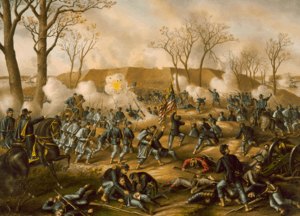
On November 7, 1861, Grant and his troops crossed the Mississippi and attacked Confederate soldiers encamped in Belmont, Missouri, although he had no orders to do so from Union command.[69] They took the camp, but the reinforced Confederates under Brigadier General Gideon J. Pillow forced a retreat to Cairo. A tactical defeat, the battle nonetheless gave Grant and his volunteers confidence and experience.[70] After Belmont, Grant asked his new commander Henry Halleck (Lincoln had relieved Frémont of command) for permission to move against Fort Henry in Tennessee, which would open the Tennessee River to Union gunboats; Halleck agreed on condition that the attack be conducted in coordination with navy Flag Officer Andrew H. Foote.[71] Grant's troops, in close cooperation with Foote's naval forces captured Fort Henry on February 6, 1862.
Emboldened by Lincoln's call for a general advance of all Union forces, Grant ordered an immediate assault on nearby Fort Donelson, which dominated the Cumberland River (this time without Halleck's permission). On February 15, Grant and Foote met stiff resistance from Confederate forces under Pillow. Reinforced by 10,000 troops, Grant's army totaled 25,000 troops against 12,000 Confederates. Foote's first approach was repulsed, and the Confederates attempted a breakout, pushing Grant's right flank into disorganized retreat.[72] Grant rallied his troops, resumed the offensive, retook the Union right, and attacked Pillow's left. Pillow ordered Confederate troops back into the fort and relinquished command to Brigadier General Simon Bolivar Buckner, who the next day acceded to Grant's demand for his "unconditional and immediate surrender." Lincoln promoted Grant to major-general of volunteers while the Northern press treated Grant as a hero. Playing off his initials, they took to calling him "Unconditional Surrender Grant".[73]
Shiloh and aftermath

Encamped on the western bank of the Tennessee River, Grant's Army of the Tennessee, now numbering about 45,000 troops, prepared to attack a Confederate army of roughly equal strength at Corinth, Mississippi, a vital railroad junction. The Confederates, led by Generals Albert Sidney Johnston and P.G.T. Beauregard, struck first on April 6, 1862, attacking five divisions of Grant's army bivouacked at Pittsburg Landing, not far from the Shiloh meetinghouse.[74] Grant's troops were not entrenched and were taken by surprise, falling back before the Confederate onslaught.[75] At day's end, the Confederates captured one Union division, but Grant's army was able to hold the Landing.[76] The remaining Union army might have been destroyed, but the Confederates halted due to exhaustion, confusion, and a lack of reinforcements.[77] Grant, bolstered by 18,000 fresh troops from the divisions of Major Generals Don Carlos Buell and Lew Wallace, counterattacked at dawn the next day [78] The Northerners regained the field and forced the rebels to retreat back to Corinth.[79]
In Shiloh's aftermath, the Northern press criticized Grant for high casualties and for his alleged drunkenness during the battle.[80] Shiloh was the costliest battle in American history to that point, with total casualties of about 23,800.[81] Halleck arrived at Pittsburg Landing on April 9, and removed Grant from field command, proceeding to capture Corinth. Discouraged and disappointed, Grant considered resigning his commission, but Brigadier General William Tecumseh Sherman, one of his division commanders, convinced him to stay.[82] Lincoln overruled Grant's critics, saying "I can't spare this man; he fights." Ordered to Washington, Halleck on July 11 reinstated Grant as field commander of the Army of the Tennessee.[83] On September 19, Grant's army defeated Confederates at the Battle of Iuka, then successfully defended Corinth, inflicting heavy casualties on the enemy.[84] On October 25, Grant assumed command of the District of the Tennessee.[85] In November, after Lincoln's preliminary Emancipation Proclamation, Grant ordered units under his command, headed by Chaplain John Eaton, to incorporate contraband slaves into the Union war effort, giving them clothes, shelter, and wages for their services.[86]
Vicksburg campaign
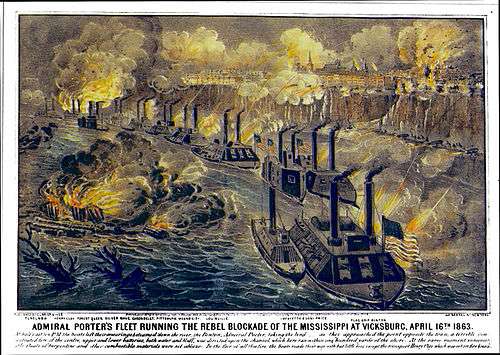
.tif.jpg)
Located on the high bluffs of the Mississippi River, Vicksburg, Mississippi, was the last major obstacle to Union control of that river; both Lincoln and Grant saw it as the key to victory in the West and were determined to take the rebel stronghold. Grant's Army held western Tennessee having almost 40,000 troops available to fight.[87] Grant was aggravated to learn that Lincoln authorized Major General John A. McClernand to raise a separate army for the purpose.[88] Halleck ordered McClernand to Memphis, and placed him under Grant's authority.[89] Grant planned to attack Vicksburg on land from the east while Sherman attacked the fortress from the Mississippi River, but two Confederate cavalry raids, on December 11 and 20, prevented the armies from connecting.[90] On December 29, a Confederate army led by Lieutenant General John C. Pemberton repulsed Sherman's direct approach to Vicksburg at Chickasaw Bayou.[91] McClernand reached Sherman's army, assumed command, and independently of Grant led a campaign that captured Confederate Fort Hindman.[92]
Along with his military responsibilities in the months following Grant's return to command, he was concerned over an expanding illicit cotton trade in his district.[93] He believed the trade undermined the Union war effort, funded the Confederacy, and prolonged the war, while Union soldiers died in the fields.[94] On December 17, he issued General Order No. 11, expelling "Jews, as a class," from the district, saying that Jewish merchants were violating trade regulations.[95] Writing in 2012, historian Jonathan D. Sarna said Grant "issued the most notorious anti-Jewish official order in American history."[96] Historians' opinions vary on Grant's motives for issuing the order.[97] Jewish leaders complained to Lincoln while the Northern press criticized Grant.[98] Lincoln demanded the order be revoked and Grant rescinded it within three weeks.[99] When interviewed years after the war, in response to accusations of his General Order being anti-Jewish, Grant explained: "During war times these nice distinctions were disregarded, we had no time to handle things with kid gloves."[100] Grant made amends with the Jewish community during his presidency.[101]
On January 29, 1863, Grant assumed personal overall command and during the months of February and March made a series of attempts to advance his army through water-logged terrain to bypass Vicksburg's guns; these also proved ineffective, however, Union soldiers became better trained.[102] On April 16, 1863, Grant ordered Admiral David Porter's Union gunboats south under fire from the Vicksburg batteries to meet up with his Union troops who had marched south down the west side of the Mississippi River.[103] Grant ordered diversionary battles, confusing Pemberton and allowing Grant's army to cross east over the Mississippi, landing troops at Bruinsburg.[104] Continuing eastward, Grant's army captured Port Gibson, Raymond, and Jackson, the state capital and Confederate railroad supply center. Advancing his army to Vicksburg, Grant defeated Pemberton's army at the Battle of Champion Hill on May 16, forcing Pemberton to retreat into Vicksburg.[105] After Grant's men assaulted the Vicksburg entrenchments twice, suffering severe losses, they settled in for a siege lasting seven weeks. Pemberton surrendered Vicksburg to Grant on July 4, 1863.[106]
The fall of Vicksburg gave Union forces control over the Mississippi River and split the Confederacy in two. By that time, Grant's political sympathies fully coincided with the Radical Republicans' aggressive prosecution of the war and emancipation of the slaves.[107] Although the success at Vicksburg was a great morale boost for the Union war effort, Grant received criticism for his decisions and his alleged drunkenness.[108] The personal rivalry between McClernand and Grant continued after Vicksburg, until Grant removed McClernand from command when he contravened Grant by publishing an order without permission.[109] When Secretary of War Edwin M. Stanton suggested Grant be brought back east to run the Army of the Potomac, Grant demurred, writing that he knew the geography and resources of the West better and he did not want to upset the chain of command in the East.[110]
Chattanooga and promotion

Lincoln commissioned Grant a major general in the regular army and assigned him command of the newly formed Division of the Mississippi in October 1863, including the Armies of the Ohio, Tennessee, and Cumberland.[111][112] After the Battle of Chickamauga, the Army of the Cumberland retreated into Chattanooga, where they were trapped.[113] When informed of the situation, Grant put Major General George H. Thomas in charge of the besieged army.[114] Taking command, Grant arrived in Chattanooga by horseback, devising plans to resupply the city and break the siege.[115] Lincoln also sent Major General Joseph Hooker and two divisions of the Army of the Potomac to assist.[116] Union forces captured Brown's Ferry and opened a supply line to Bridgeport.[117] On November 23, 1863, Grant organized three armies to attack at Missionary Ridge and Lookout Mountain.[118] Two days later in the early morning, Hooker's forces successfully took Lookout Mountain.[118] Grant ordered Thomas and the Army of the Cumberland to advance when Sherman's army failed to take Missionary Ridge from the northeast.[119] The Army of the Cumberland, led by Major General Philip Sheridan and Brigadier General Thomas J. Wood, charged uphill and captured the Confederate entrenchments on top of the ridge, forcing the rebels into disorganized retreat.[120] The decisive battle gave the Union control of Tennessee and opened Georgia, the heartland of the Confederacy, to Union invasion.[121]
On March 3, 1864, Lincoln promoted Grant to lieutenant general, giving him command of all Union Armies, answering only to the President.[122] Grant assigned Sherman the Division of the Mississippi and traveled east to Washington D.C., meeting with Lincoln to devise a strategy of total war against the Confederacy. After settling Julia into a house in Georgetown, Grant established his headquarters with General George Meade's Army of the Potomac in Culpeper, Virginia.[123] He devised a strategy of coordinated Union offensives, attacking the rebel armies at the same time to keep the Confederates from shifting reinforcements within their interior lines. Sherman was to pursue Joseph E. Johnston's Army of Tennessee, while Meade would lead the Army of the Potomac, with Grant in camp, to attack Robert E. Lee's Army of Northern Virginia.[124] Major General Benjamin Butler was to advance towards Richmond from the south, up the James River.[125] If Lee was forced south as expected, Grant would join forces with Butler's armies and be fed supplies from the James. Major General Franz Sigel was to capture the railroad line at Lynchburg, move east, and attack from the Blue Ridge Mountains.[126] Grant knew that Lee had limited manpower and that a war of attrition fought on a battlefield without entrenchments would lead to Lee's defeat.[127]
Grant was now riding a rising tide of popularity, and there was talk that a Union victory early in the year could lead to his candidacy for the presidency. Grant was aware of the rumors, but had ruled out a political candidacy; the possibility would soon vanish with delays on the battlefield.[127]
Overland Campaign and Union victory

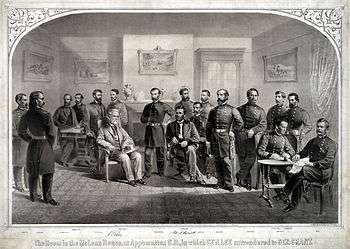
Sigel's and Butler's efforts sputtered, and Grant was left alone to fight Lee in a series of bloody battles known as the Overland Campaign. Grant crossed the Rapidan River on May 4, 1864, and attacked Lee in the Battle of the Wilderness, a hard-fought three-day battle with many casualties. Rather than retreat as his predecessors had done, Grant flanked Lee's army to the southeast and attempted to wedge his forces between Lee and Richmond at Spotsylvania Court House.[128] Lee's army got to Spotsylvania first, and a costly battle ensued, lasting thirteen days. During the battle, Grant attempted to break through Lee's line of defense, resulting in one of the bloodiest assaults of the Civil War, known as the Battle of the Bloody Angle. Unable to break Lee's defenses, Grant again flanked the Confederate army to the southeast, meeting at North Anna, where a battle lasted three days.[129] The Confederates had the defensive advantage, and Grant maneuvered his army to Cold Harbor, a vital railroad hub that linked to Richmond, but Lee's men were again able to entrench against the Union assault. During the third day of the thirteen-day battle, Grant led a costly assault on Lee's trenches. As casualty reports became known in the North, heavy criticism fell on Grant, who was castigated as "the Butcher" by the Northern press after taking 52,788 casualties in the thirty days since crossing the Rapidan. Lee's army suffered 32,907 casualties, but he was less able to replace them.[130] The costly Union assault at Cold Harbor was the second of two battles in the war that Grant later said he regretted (the other being his initial assault on the fortifications around Vicksburg). Without being detected by Lee, Grant pulled out of Cold Harbor and moved his army south of the James River, freed Butler from the Bermuda Hundred (where the Rebels had surrounded his army), and advanced toward Petersburg, Richmond's central railroad hub.[131]

After crossing the James River undetected, Grant and the Army of the Potomac arrived at Petersburg. Confederate General P.G.T. Beauregard defended the city, and Lee's veteran reinforcements soon arrived. The result was a nine-month-long siege of Petersburg, stalling the advance. Northern resentment grew as the war dragged on, but an indirect benefit of the Petersburg siege was that Lee was forced to entrench and defend Richmond, and was unable to reinforce the Army of the Tennessee. Sheridan was assigned command of the Union Army of the Shenandoah and Grant directed him to "follow the enemy to their death". Lee had sent General Jubal Early up the Shenandoah Valley to attack the federal capital and draw troops away from the Army of the Potomac, but Sheridan defeated Early, ensuring that Washington would not be endangered. Grant then ordered Sheridan's cavalry to destroy vital Confederate supplies in the Shenandoah Valley. When Sheridan reported suffering attacks by irregular Confederate cavalry under John S. Mosby, Grant recommended rounding up their families for imprisonment as hostages at Fort McHenry.[132]
At Petersberg, Grant approved of a plan to blow up part of the enemy trenches from an underground tunnel. The explosion created a crater, into which poorly-led Union troops poured. Recovering from the surprise, Confederates surrounded the crater and easily picked off Union troops within it. The Union's 3500 casualties outnumbered the Confederates' by three-to-one; although the plan could have been successful if implemented correctly, Grant admitted the tactic had been a "stupendous failure".[133] On August 9, 1864, Grant, who had just arrived at his headquarters in City Point, narrowly escaped death when Confederate spies blew up an ammunition barge in the James River.[134] Rather than fight Lee in a full frontal attack as he had done at Cold Harbor, Grant continued to extend Lee's defenses south and west of Petersburg, to capture vital railroad links.[135] As Grant continued to push the Union advance westward, Lee's lines became overstretched and undermanned. After the Federal army rebuilt the City Point Railroad, Grant was able to use mortars to attack Lee's entrenchments.[136] On September 2, Sherman captured Atlanta while Confederate forces retreated, ensuring Lincoln's reelection in November.[137] Sherman convinced Grant and Lincoln to send his army to march on Savannah devastating the Confederate heartland.[138]
Once Sherman reached the East Coast and Thomas dispatched John Bell Hood's forces in Tennessee, Union victory appeared certain, and Lincoln attempted negotiations. He enlisted Francis Preston Blair to carry a message to Confederate President Jefferson Davis. Davis and Lincoln each appointed commissioners, but the conference soon stalled. Grant contacted Lincoln, who agreed to personally meet with the commissioners at Fort Monroe. The peace conference that took place near Union-controlled Fort Monroe was ultimately fruitless, but represented Grant's first foray into diplomacy.[139]

In late March 1865, Grant's forces finally took Petersburg, then captured Richmond that April. Grant, Sherman, Admiral Porter and Lincoln held a conference on the River Queen to discuss Reconstruction of the South.[140] Lee's troops began deserting in large numbers; disease and lack of supplies also diminished the remaining Confederates. Lee attempted to link up with the remnants of Joseph E. Johnston's defeated army, but Union cavalry forces led by Sheridan were able to stop the two armies from converging, cutting the line of advance to the Confederate supply trains. Lee and his army surrendered to Grant at Appomattox Court House on April 9, 1865. Going beyond his military authority, Grant, in effect, gave Lee and his men amnesty; Confederate troops surrendered their weapons and were allowed to return to their homes, on the condition that they would not take up arms against the United States.[141] On April 26, Johnson's Confederate army surrendered to Sherman under the same terms Grant offered to Lee.[142] On May 26, Kirby Smith's western Confederate army surrendered and the Civil War was over, ending in Union victory.[143]
Lincoln's assassination
On April 14, five days after Grant's victory at Appomattox, he attended a cabinet meeting in Washington. Lincoln invited him and his wife to Ford's Theater, but they declined as they had plans to travel to Philadelphia. In a conspiracy that targeted several government leaders, Lincoln was fatally shot by John Wilkes Booth at the theater, and died the next morning.[144] Many, including Grant himself, thought that he had been a target in the plot.[145] Secretary of War Stanton notified him of the President's death and summoned him back to Washington. Attending Lincoln's funeral on April 19, Grant stood alone and wept openly; he later said Lincoln was "the greatest man I have ever known."[146] Regarding the new President, Andrew Johnson, Grant told Julia that he dreaded the change in administrations; he judged Johnson's attitude toward white southerners as one that would "make them unwilling citizens", and initially thought that with President Johnson, "Reconstruction has been set back no telling how far."[147]
Commanding General
Beginning Reconstruction
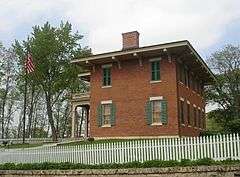
At the war's end, Grant remained commander of the army, with duties that included enforcement of Reconstruction Acts in the former Confederate states and supervision of Indian wars on the western Plains.[148] Grant secured a house for his family in Georgetown Heights in 1865, but instructed Elihu Washburne that for political purposes his legal residence remained in Galena, Illinois.[149] That same year, Grant spoke at Cooper Union in New York, where the New York Times reported that "... the entranced and bewildered multitude trembled with extraordinary delight." Further travels that summer took the Grants to Albany, New York, back to Galena, and throughout Illinois and Ohio, with enthusiastic receptions.[150]
In November 1865, President Andrew Johnson sent Grant on a fact-finding mission to the South. Afterwards, Grant recommended continuation of a reformed Freedmen's Bureau, which Johnson opposed, but advised against the use of black troops in garrisons, which he believed encouraged an alternative to farm labor.[151] Grant did not believe the people of the devastated South were ready for civilian self-rule, and that both whites and blacks in the South required protection by the federal government.[152] He also warned of threats by disaffected poor people, black and white, and recommended that local decision-making be entrusted only to "thinking men of the South" (i.e., white men of property).[153] In this respect, Grant's opinion on Reconstruction aligned with Johnson's policy of pardoning established southern leaders and restoring them to their positions of power.[154] He joined Johnson in arguing that Congress should allow representatives from the South to take their seats.[155] On July 25, 1866, Congress promoted Grant to the newly created rank of General of the Army of the United States.[156]
Breach with Johnson
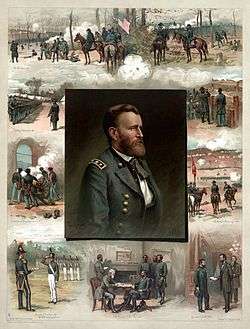
Johnson favored a lenient approach to Reconstruction, calling for an immediate return of the former Confederate states into the Union without any guarantee of African American civil rights.[157] The Radical Republican-controlled Congress opposed the idea and refused to admit Congressmen from the former Confederate states.[158] Over Johnson's vetoes, Congress renewed the Freedmen's Bureau and passed the Civil Rights Act of 1866. During the congressional election campaign later that year, Johnson took his case to the people in his "Swing Around the Circle" speaking tour.[159] Johnson pressured Grant, by then the most popular man in the country, to go on the tour; Grant, wishing to appear loyal, agreed.[160] Grant believed that Johnson was purposefully agitating conservative opinion to defy Congressional Reconstruction.[157] Finding himself increasingly at odds with Johnson, Grant confided to his wife that he thought the President's speeches were a "national disgrace".[157] Publicly, Grant attempted to appear loyal to Johnson while not alienating Republican legislators essential to his future political career. Concerned that Johnson's differences with Congress would cause renewed insurrection in the South, he ordered Southern arsenals to ship arms north to prevent their capture by Southern state governments.[161]
Conflict between radicals and conservatives continued after the 1866 congressional elections. Rejecting Johnson's vision for quick reconciliation with former Confederates, Congress passed the Reconstruction Acts, which divided the southern states into five military districts to protect the freedman's constitutional and congressional rights. Military district governors were to lead transitional state governments in each district. Grant, who was to select the general to govern each district from a group designated by Johnson, preferred Congress's plan for enforcement of Reconstruction.[162] Grant was optimistic that Reconstruction Acts would help pacify the South.[163] By complying with the Acts and instructing his subordinates to do likewise, Grant further alienated Johnson. When Sheridan removed public officials in Louisiana who impeded Reconstruction, Johnson was displeased and sought Sheridan's removal.[164] Grant recommended a rebuke, but not a dismissal.[165] Throughout the Reconstruction period, Grant and the military protected the rights of more than 1,500 African Americans elected to political office.[166] In 1866, Congress renewed the Freedmen's Bureau over Johnson's vetoes and with Grant's support, and passed the first Civil Rights Act protecting African American civil rights by nullifying black codes.[167] On July 19, 1867, Congress, again over Johnson's veto, passed a measure that authorized Grant to have oversight in enforcing congressional Reconstruction, making Southern state governments subordinate to military control.[168]
Johnson's impeachment
Johnson wished to replace Stanton, a Lincoln appointee who sympathized with Congressional Reconstruction. To keep Grant under control as a potential political rival, Johnson asked him to take the post. Grant recommended against the move, in light of the Tenure of Office Act, which required Senate approval for cabinet removals. Johnson believed the Act did not apply to officers appointed by the previous president, and forced the issue by making Grant an interim appointee during a Senate recess. Grant agreed to accept the post temporarily, and Stanton vacated the office until the Senate reconvened.[169]
When the Senate reinstated Stanton, Johnson told Grant to refuse to surrender the office and let the courts resolve the matter. Grant told Johnson in private that violating the Tenure of Office Act was a federal offense, which could result in a fine or imprisonment. Believing he had no other legal alternatives, Grant returned the office to Stanton. This incurred Johnson's wrath; at a cabinet meeting immediately afterward, Johnson accused Grant of breaking his promise to remain Secretary of War. Grant disputed that he had ever made such a promise although cabinet members later testified he had done so.[170] Newspapers friendly to Johnson published a series of articles to discredit Grant over returning the War Department to Stanton, stating that Grant had been deceptive in the matter.[170] This public insult infuriated Grant, and he defended himself in an angry letter to Johnson, after which the two men were confirmed foes. When Grant's statement became public, it increased his popularity among Radical Republicans and he emerged from the controversy unscathed.[170] Although Grant favored Johnson's impeachment, he took no active role in the impeachment proceedings against Johnson, which were fueled in part by Johnson's removal of Stanton. Johnson barely survived, and none of the other Republican leaders directly involved benefited politically in their unsuccessful attempt to remove the president.[171]
Election of 1868
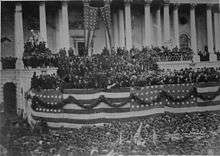
While remaining Commanding General, Grant entered the 1868 campaign season with increased popularity among the Radical Republicans following his abandonment of Johnson over the Secretary of War dispute. The Republicans chose Grant as their presidential candidate on the first ballot at the 1868 Republican National Convention in Chicago.[lower-alpha 3] In his letter of acceptance to the party, Grant concluded with "Let us have peace", which became his campaign slogan.[173] For vice president, the delegates nominated House Speaker Schuyler Colfax. Grant's 1862 General Order No. 11 became an issue during the presidential campaign; he sought to distance himself from the order, saying "I have no prejudice against sect or race, but want each individual to be judged by his own merit."[174] As President, Grant would atone for 1862's expulsion of the Jews. Historian Jonathan Sarna argues that Grant became one of the greatest friends of Jews in American history, meeting with them often and appointing them to high office. He was the first president to condemn atrocities against Jews in Europe, thus putting human rights on the American diplomatic agenda.[175] As was expected at the time, Grant returned to his home state[lower-alpha 4] and left the active campaigning and speaking on his behalf to his campaign manager William E. Chandler and others.[178] The Republican campaign focused on continuing Reconstruction and restoring the public credit. [179]
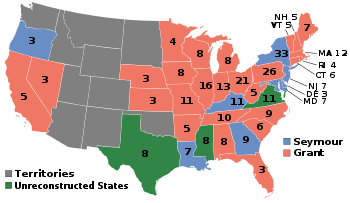
The Democrats nominated former New York Governor Horatio Seymour. Their campaign focused mainly on ending Reconstruction and returning control of the South to the white planter class, which alienated many War Democrats in the North.[180] The Democrats attacked Reconstruction and the Republican Party's support of African American rights, while deriding Grant, calling him captain of the "Black Marines".[181] Grant won the election by 300,000 votes out of 5,716,082 votes cast, receiving an electoral college landslide, of 214 votes to Seymour's 80. Grant, at the age of 46 was (at the time) the youngest president ever elected. His election was a triumph of conservative principles that included sound money, efficient government, and the restoration of Southern reconstructed states.[182] Grant was the first president elected after the nation had outlawed slavery and granted citizenship to former slaves. Implementation of these new rights was slow to come; in the 1868 election, the black vote counted in only 16 of the 37 states, nearly all in the South.[183] Grant lost Louisiana and Georgia primarily due to Ku Klux Klan violence against African American voters.[184] During the election there was a noticeably large number of black citizens in Washington.[185]
Presidency (1869–77)
.tif.jpg)

On March 4, 1869, Grant was sworn in as the eighteenth President of the United States by Chief Justice Salmon P. Chase. His presidency began with a break from tradition, as Johnson did not attend Grant's inauguration at the Capitol or ride with him as he departed the White House for the last time.[185] In his inaugural address, Grant urged the ratification of the Fifteenth Amendment and said he would approach Reconstruction "calmly, without prejudice, hate or sectional pride."[186] He also recommended the "proper treatment" of Native Americans be studied; advocating their civilization and eventual citizenship.[187] Grant took an unconventional approach to choosing his cabinet, declining to consult with the Senate and keeping his choices secret until he submitted them for confirmation.[188] In his effort to create national harmony, Grant purposely avoided choosing Republican Party leaders.[189] He appointed his wartime comrade John A. Rawlins as Secretary of War and Hamilton Fish, a conservative New York statesman, as Secretary of State. Sherman earned promotion to Commanding General, but his relationship with Grant became strained when the President took Rawlins's side to limit Sherman's authority. Grant initially ordered Sherman command over War Department bureau chiefs and their departments, but rescinded it when Rawlins and Congress complained.[190] Rawlins died in office a few months later, and Grant appointed William W. Belknap as his replacement, who continued to undermine Sherman's authority.[189]
Grant selected several non-politicians to his cabinet, including Adolph E. Borie and Alexander Turney Stewart, with limited success. Borie served briefly as Secretary of the Navy, later replaced by George M. Robeson, while Stewart was prevented from becoming Secretary of the Treasury by a 1789 statute that barred businessmen from the position (Senators Charles Sumner and Roscoe Conkling opposed amending the law.)[191] In place of Stewart, Grant appointed Massachusetts Representative George S. Boutwell, a radical, as Treasury Secretary. His other cabinet appointments—Jacob D. Cox (Interior), John Creswell (Postmaster General), and Ebenezer Rockwood Hoar (Attorney General)—were well-received and uncontroversial.[192] Grant also appointed four Justices to the Supreme Court: William Strong, Joseph P. Bradley, Ward Hunt and Chief Justice Morrison Waite.[193] Hunt voted to uphold Reconstruction laws while Waite and Bradley did much to undermine them.[194]
Later Reconstruction and civil rights
Starting in 1869, Grant's management of the Reconstruction of former Confederate states was controversial.[195] Unlike his predecessor, Grant advocated systematic federal enforcement of fundamental civil rights regardless of race.[196] He lobbied Congress to pass the Fifteenth Amendment, guaranteeing that no state could prevent someone from voting based on race, and believed that its passage would secure freedmen's rights. Grant asked Congress to admit representatives from the remaining unrepresented Southern states in conformity with Congressional Reconstruction; they did so, passing legislation providing that Mississippi, Virginia, and Texas would be represented in Congress after they ratified the Fifteenth Amendment.[197] Grant pressured Congress to draw up legislation that would seat African American state legislators in Georgia, who had been ousted by white conservatives.[198] Congress responded through special legislation; the members were re-seated in the Georgia legislature, and Georgia was required to adopt the Fifteenth Amendment to gain representation in Congress.[198] By July 1870, the four remaining states were readmitted.[198]
To bolster the new amendment, Grant relied on the army and in 1870 he signed legislation creating the Justice Department, primarily to enforce federal laws in the South. Where the attorney general had once been only a legal adviser to the president, he now led a cabinet department dedicated to enforcing federal law, including a solicitor general to argue on the government's behalf in court.[199] Under Grant's first attorney general, Ebenezer R. Hoar, the administration was not especially aggressive in prosecuting white Southerners who terrorized their black neighbors, but Hoar's successor, Amos T. Akerman, was more zealous. Alarmed by a rise in terror by the Ku Klux Klan and other groups against African Americans, Congress (with Grant's encouragement) passed a series of three laws, the Enforcement Acts from 1870 to 1871, which made depriving African Americans their civil rights a federal offense and authorized the president to use the military to enforce the laws.[200] In May 1871, Grant ordered federal troops to help marshals in arresting Klansmen. That October, on Akerman's recommendation, Grant suspended habeas corpus in part of South Carolina and sent federal troops to enforce the law there. After prosecutions by Akerman and his replacement, George Henry Williams, the Klan's power collapsed; by 1872, elections in the South saw African Americans voting in record numbers.[201] That same year, Grant signed the Amnesty Act, which restored political rights to former Confederates. Lacking sufficient funding, the Justice Department stopped prosecutions of the Klan in June 1873, and Grant offered the Klan clemency in exchange for peace.[202] The Justice Department's civil rights prosecutions continued throughout Grant's second term but with fewer yearly cases and minimal convictions.[203]
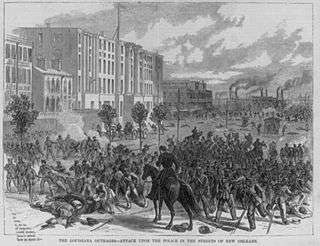
After the Klan's decline, other conservative whites formed armed groups, such as the Red Shirts and the White League who openly used violence and intimidation to take control of state governments.[204] The Panic of 1873 and the ensuing depression contributed to public fatigue, and the North grew less concerned with Reconstruction.[205] Supreme Court rulings in the Slaughter-House Cases (1873) and United States v. Cruikshank (1875) restricted federal enforcement of civil rights.[206] Grant began to favor limiting the use of troops, to avoid the impression that he was acting as a military dictator; he was also concerned that increased military pressure in the South might cause conservative whites in the North to bolt the Republican Party. In 1874, Grant by proclamation ended the Brooks–Baxter War bringing Reconstruction in Arkansas to a peaceful conclusion, but that same year, he sent troops and warships under Major General William H. Emory to New Orleans in the wake of the Colfax Massacre and disputes over the election of Governor William Pitt Kellogg.[207] Emory peacefully restored Kellogg to office and the following year the parties reached a compromise allowing Democrats to retain control of the Louisiana House.[208] Under public pressure Grant recalled General Sheridan and most of the federal troops from Louisiana.[209]
By 1875, Democratic "Redeemer" politicians took control of all but three Southern states. As violence against black Southerners escalated once more, Edwards Pierrepont (Grant's fourth attorney general) told Governor Adelbert Ames of Mississippi that the people were "tired of the autumnal outbreaks in the South", and declined to intervene directly, instead, sending an emissary to negotiate a peaceful election.[210] Grant signed an ambitious Civil Rights Act of 1875, which expanded federal law enforcement by prohibiting discrimination on account of race in public lodging, public transportation, and jury service.[209] However, it did not stop the rise of white supremacist forces in the South.[211] In October 1876, Grant sent troops to South Carolina to aid Republican Governor Daniel Chamberlain.[212] Even so, the remaining three Republican governments in the South fell to Redeemers after the 1876 presidential election, and the ensuing Compromise of 1877 marked the end of Reconstruction.[213][lower-alpha 5]
During his Presidency, Grant spoke out against voter intimidation against blacks in the South.[214] Grant told Americans, Treat the negro as a citizen and a voter, as he is and must remain, and soon parties will be divided, not on the color line, but on principle.[214]
Indian peace policy
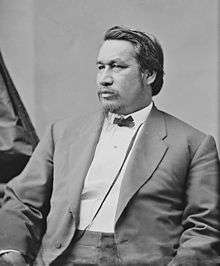
Grant's attempts to live peacefully with Native Americans marked a radical reversal of what had since the 1830s been the government's policy of Indian removal. He appointed Ely S. Parker, a Seneca Indian and member of his wartime staff, as Commissioner of Indian Affairs. "My efforts in the future will be directed," Grant said in his second inaugural address, "by a humane course, to bring the aborigines of the country under the benign influences of education and civilization ... Wars of extermination ... are demoralizing and wicked." Grant's "Peace Policy" aimed to replace entrepreneurs serving as Indian agents with missionaries.[215] In 1869, Grant signed a law establishing a Board of Indian Commissioners to oversee spending and reduce corruption in the Bureau of Indian Affairs.[216] Two years later, he signed a bill ending the Indian treaty system; the law now treated individual Native Americans as wards of the federal government, and no longer dealt with the tribes as sovereign entities.[217] Grant wished for Indian tribes to be protected on reservations and educated in European-style farming and culture, abandoning their hunter-gatherer way of life.[215] Although, as biographer Jean Edward Smith wrote, Grant's peace policy was "remarkably progressive and humanitarian" for its time, it ultimately disregarded native cultures, something modern Americans see "as a grave error."[218]
The peace policy showed some success in reducing battles between Indians and whites on the western frontier, but the increased slaughter of the buffalo, encouraged by Grant's subordinates, led to conflict with the Plains Indians.[219] The Sioux and other Plains tribes accepted the reservation system, but encroachments by whites in search of gold in the Black Hills led to renewed war by the end of Grant's second term, ending the understanding that had developed between Grant and Sioux Chief Red Cloud.[220] Under Major Generals Oliver Otis Howard and George Crook, Grant's policy had greater success in the Southwest. Howard, the former head of the Freedmen's Bureau, negotiated peace with the Apache in 1872, convincing their leader, Cochise, to move the tribe to a new reservation, and ending a war started the year before. In Oregon, relations were less peaceful, as war with the Modocs erupted in April 1873. The Modocs refused to move to a reservation and killed the local army commander, Major General Edward Canby. Although Grant was upset over Canby's death, he ordered restraint, disregarding Sherman's advice to seek revenge or exterminate the tribe. The army captured, tried, and executed the four Modoc warriors responsible for Canby's murder in October 1873. Grant ordered the rest of the Modoc tribe relocated to the Indian Territory.[221]
During the Great Sioux War, fueled by the discovery of gold in the Black Hills, Grant came into conflict with Colonel George Armstrong Custer after Custer testified in 1876 about corruption in the War Department. Grant ordered Custer arrested for breach of military protocol and barred him from leading an upcoming campaign against the Sioux. Grant later relented and let Custer fight under Brigadier General Alfred Terry.[222] Sioux warriors led by Crazy Horse killed Custer at the Battle of the Little Big Horn, the army's most famous defeat in the Indian wars. Two months later, Grant castigated Custer in the press, saying "I regard Custer's massacre as a sacrifice of troops, brought on by Custer himself, that was wholly unnecessary – wholly unnecessary."[223] Custer's death shocked the nation, leading Congress to appropriate funds for more troops, two more Western forts and barred Indians from purchasing weapons.[222]
Foreign affairs
As early as 1846, American expansionists desired U.S. naval control over the Dominican Republic.[224] The Johnson administration recommended that Congress lease Samaná Bay as a naval base, but anti-imperialist Republicans in Congress rejected the plan.[225] In 1869, New England businessman Joseph W. Fabens, employed by the Dominican government, urged Fish to admit Santo Domingo (as the Dominican Republic was then known) as a state.[224] Fish informed Grant of Faben's memorandum at a cabinet meeting, but since Congress was about to adjourn, discussion on the issue was tabled.[224] Knowing that Congressmen John Logan and Nathaniel Banks supported annexation, Grant secretly sent his trusted wartime confidant, Orville E. Babcock, to Santo Domingo and consult with Buenaventura Báez, the pro-annexation Dominican president.[226] Although Fish did not give Babcock diplomatic authority, Babcock returned to Washington in September 1869 having a draft annexation treaty he made with Báez.[227] Grant accepted Babcock's findings and sent him back to Santo Domingo, this time with the authority to negotiate treaties of annexation or the lease of Samaná Bay. [228] Babcock returned to Washington and the two treaties were discussed at a cabinet meeting on December 21.[229] Fish dismissed annexation, seeing the island as politically unstable and troublesome.[230]
Grant, who supported the treaties, believed in a peaceful expansion of the nation's borders, thought acquisition of the majority-black nation would allow new economic opportunities for African Americans in the United States while increasing American naval power in the Caribbean, and believed the island would offer a refuge for black Americans suffering from violent attacks in the South.[231][232] On January 2, 1870, Grant lobbied Senator Charles Sumner at his home in hopes of influencing him to help get the Senate to pass the treaties.[233][234] In March, he further lobbied Senators at the Capitol and the White House.[235] Fish added to the effort out of loyalty to the administration, but to no avail; Sumner was set against annexation and the Senate refused to pass the treaties.[236] Sumner's opposition led to political enmity between him and Grant.[237] A congressional investigation in 1870 by Senator Carl Schurz revealed that land speculators also backed the treaty in hope of private financial gain.[238] After the Dominican initiative failed, Grant convinced Fish to stay in the cabinet and gave him greater authority to run the State Department.[239] Unwilling to admit defeat, Grant successfully lobbied Congress to send a commission to the West Indies to investigate, including Frederick Douglass.[240] Although Douglass and the commission approved of Grant's claims for annexation in its findings released on April 5, 1871, the Senate remained opposed while Grant was forced to abandon further annexation attempts.[241]
Grant and Fish were more successful in their resolution of the Alabama claims. This dispute with the United Kingdom stemmed from the damage done to American shipping during the Civil War by the five ships built for the Confederacy in British shipyards including, most famously, the CSS Alabama.[242] The Americans claimed that Britain had violated neutrality by building ships for the Confederate Navy.[243] When the war ended, the United States demanded restitution, which the British refused to pay. Negotiations continued fitfully, a sticking point being the claims of "indirect damages" on top of the harm directly caused by the five ships.[244] Sumner opposed the Johnson administration's proposed settlement, which had been rejected by the Senate, believing that Britain should directly pay $2 billion in gold or, alternatively, cede Canada to the United States.[245] Fish and Boutwell convinced Grant that peaceful and financial relations with Britain were more important than acquisition of more territory, and the two nations agreed to negotiate along those lines.[246] A commission in Washington produced a treaty whereby an international tribunal would settle the damage amounts; the British admitted regret, but not fault.[lower-alpha 6] The Senate approved the Treaty of Washington, which also settled disputes over fishing rights and maritime boundaries, by a 50–12 vote in 1871.[247]
In October 1873, a Spanish cruiser took captive a merchant ship, Virginius, flying the U.S. flag, carrying war materials and men to aid the Cuban insurrection. The passengers and crew, including eight American citizens, were illegally traveling to Cuba to help overthrow the government. Spanish authorities executed the prisoners, and many Americans called for war with Spain. Fish, with Grant's support, worked to reach a peaceful resolution. Spain's President, Emilio Castelar y Ripoll, expressed regret for the tragedy and agreed to decide reparations through arbitration; Spain surrendered the Virginius and paid a cash indemnity of $80,000 to the families of the executed Americans.[248]
Grant condemned slavery in Cuba, urging Spain to reform.[249] In June 1874, Secretary of the Navy George M. Robeson commissioned the reconstruction of five redesigned double-turreted monitor warships to compete with the superior Spanish Navy.[250] The administration's diplomacy was also at work in the Pacific as, in December 1874, Grant held a state dinner at the White House for the King of Hawaii, David Kalakaua, who was seeking duty-free sugar importation to the United States.[251] Grant and Fish secured a free trade treaty in 1875 with the Kingdom of Hawaii, incorporating the Pacific islands' sugar industry into the United States' economic sphere.[251]
Gold standard and the Gold Ring
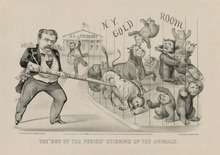
Soon after taking office, Grant took steps to return the nation's currency to a more secure footing. During the Civil War, Congress had authorized the Treasury to issue banknotes that, unlike the rest of the currency, were not backed by gold or silver. The "greenback" notes, as they were known, were necessary to pay the unprecedented war debts, but they also caused inflation and forced gold-backed money out of circulation; Grant determined to return the national economy to pre-war monetary standards.[252] Many in Congress agreed, and they passed the Public Credit Act of 1869, which guaranteed that bondholders would be repaid in gold, not greenbacks.[253] To strengthen the dollar, Treasury Secretary George S. Boutwell, backed by Grant, sold gold from the Treasury each month and bought back high-interest Treasury bonds issued during the war; this had the effect of reducing the deficit, but deflating the currency.[253]
These actions had a large impact on the gold market and the national economy.[254][255] Jay Gould, a Wall Street trader and railroad magnate, and financier Jim Fisk, seeking to drive up the gold price, enlisted the help of another speculator Abel Corbin, Grant's brother-in-law, who used his connection with the president to get inside information (the collaborators were later known as the "Gold Ring.") [256][257] Corbin convinced Grant to appoint a Gould associate, Daniel Butterfield, as assistant Treasurer, where he could gather information for the Ring.[258][259] Meanwhile, Gould and Fisk quietly stockpiled gold. Gould convinced Corbin that a high gold price would be good for the nation's prosperity, and Corbin passed this theory on to Grant, who allowed the Treasury to act accordingly.[257] After consulting in early September with Alexander Stewart (his erstwhile nominee for Treasury Secretary), Grant stopped the sale of gold, believing a higher gold price would help Western farmers.[256] By mid-September, Grant warned Boutwell to be on his guard as the gold price continued to rise, while the conspirators bought ever more and the rising price affected the wider economy.[260][257] Grant, seeing that the increase was unnatural, told Boutwell to sell gold, which reduced its price.[260] Boutwell did so the next day, on September 24, 1869, later known as Black Friday.[261] The sale of gold from the Treasury defeated Gould's scheme as the gold price plummeted, relieving the growing economic tension.[262] Gould and Fisk managed to escape without much harm to themselves.[263] Many brokerage firms collapsed while trade volume and agriculture prices plummeted, causing a mild recession, but by January 1870, the economy resumed its post-war recovery.[264]
Election of 1872

Despite his administration's many scandals, Grant continued to be personally popular.[265] A growing number of reformers, however, were disappointed by Grant's support of Reconstruction, the Gold Ring, and corruption in the New York Customs House.[266] To placate reformers, Grant created a Civil Service Commission authorized by Congress in 1871.[267] The Commission, chaired by reformer George William Curtis, proposed certain reform rules and regulations, which Grant implemented by executive order in April 1872, Congress appropriating funds in May.[268] Congress stopped funding the Commission in December 1875 having refused to pass legislation to implement its recommendations.[269] There was further division within the party between the faction most concerned with the plight of the freedmen and that concerned with the growth of industry.[270] During the war, both factions' interests had aligned, and in 1868 both had supported Grant. As the wartime coalition began to fray, Grant's alignment with the party's pro-Reconstruction elements alienated party leaders who favored an end to federal intervention in Southern racial issues.[270]

Many of that faction split from the party in 1872, calling themselves the Liberal Republican Party. Led by Charles Francis Adams of Massachusetts and Senator Carl Schurz of Missouri, they publicly denounced the federal patronage system that Sumner, a Liberal Republican sympathizer, called "Grantism" and demanded amnesty for Confederate soldiers.[271] The Liberal Republicans distrusted black suffrage and demanded literacy tests for voting while opposing federal enforcement of equal voting rights in the South.[272] The Liberal Republicans nominated Horace Greeley, another Republican who had come to dislike Grant and his policies, and Governor Benjamin Gratz Brown of Missouri for Vice President.[273] The Democrats, seeking to benefit from anti-Grant sentiment, nominated Greeley as well.[274] The rest of the Republican Party nominated Grant for reelection, with Senator Henry Wilson of Massachusetts replacing Colfax as vice-presidential nominee.[275] Wilson, viewed as a practical reformer and civil rights advocate, was meant to strengthen the Republican ticket. The Crédit Mobilier scandal revealed in September 1872, in which a railroad company bribed many members of Congress in 1868, did not involve Grant, but did ensnare Vice President Colfax and Senator Wilson, adding to the general sense of dishonesty in Washington.[276] To the Liberals' chagrin, Greeley made Grant's Southern policy, rather than reform, the main campaign issue.[277] The fusion effort failed and Grant was easily reelected. The Liberal Republicans were unable to deliver many votes, and Greeley was only successful in areas the Democrats would have carried without him.[278] A strong economy, debt reduction, lowered tariffs, repeal of the income tax, and civil service reforms helped Grant defeat the Liberal Republicans.[268] Grant won 56 percent of the popular vote and an Electoral College landslide of 286 to 66.[279][lower-alpha 7] A majority of African Americans in the South voted for Grant, while Democratic opposition remained mostly peaceful. [280] Grant predictably lost in six former slave states that wanted to see an end to Reconstruction.[249]
Panic of 1873 and loss of Congress
As his first term was ending, Grant continued to work for a strong dollar, signing into law the Coinage Act of 1873, which effectively ended the legal basis for bimetallism (the use of both silver and gold as money), and established the gold standard in practice.[281] The Coinage Act discontinued the standard silver dollar and established the gold dollar as the sole monetary standard. The result was deflation, with lower prices. Silverites who wanted more money in circulation to raise prices farmers received denounced the move as the "Crime of 1873", claiming the deflation made mortgages more burdensome for farmers.[282]
Grant's second term saw renewed economic turmoil. In September 1873, Jay Cooke & Company, a New York brokerage house, collapsed after it failed to sell all of the bonds issued by Cooke's Northern Pacific Railway.[283] The collapse sent ripples through Wall Street, and other banks and brokerages that owned railroad stocks and bonds were also ruined.[283] On September 20, the New York Stock Exchange suspended trading for ten days.[284] Grant, who knew little about finance, traveled to New York to consult leading businessmen and bankers for advice on how to resolve the crisis, which became known as the Panic of 1873.[285] Grant believed that, as with the collapse of the Gold Ring in 1869, the panic was merely an economic fluctuation that affected bankers and brokers.[286] He responded cautiously, instructing the treasury to buy $10 million in government bonds, thus injecting cash into the system. These purchases curbed the panic on Wall Street, but a five-year industrial depression, later called the Long Depression, nonetheless swept the nation.[285] Many of the nation's railroads—89 out of 364—went bankrupt.[287]

Congress hoped inflation would stimulate the economy and passed what became known as the Inflation Bill in 1874. Many farmers and workingmen favored the bill, which would have added $64 million in greenbacks to circulation, but some Eastern bankers opposed it because it would have weakened the dollar.[288] Belknap, Williams, and Interior Secretary Columbus Delano[lower-alpha 8] told Grant a veto would hurt Republicans in the November elections. Grant believed the bill would destroy the credit of the nation, and he vetoed it despite their objections.[290] Grant's veto, supported by Fish, placed him in the conservative faction of the Republican party, and was the beginning of the party's commitment to a strong gold-backed dollar.[290] Grant later pressured Congress for a bill to further strengthen the dollar by gradually reducing the number of greenbacks in circulation. When the Democrats gained a majority in the House of 169 to 109, after the 1874 elections, the lame-duck Republican Congress did so before the Democrats took office.[291] On January 14, 1875, Grant signed the Specie Payment Resumption Act into law.[290] The Resumption Act required gradual reduction of the amount of greenbacks allowed to circulate and declared that specie payment (i.e., in gold or silver) would resume in 1879.[290]
The 1874 House take over by the Democrats angered Grant. The loss was attributed to the collapsed economy and voter intimidation against blacks in the South.[214]
Gilded Age corruption and reform
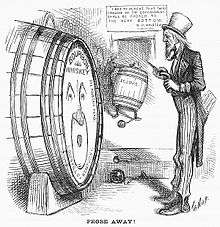
Grant served as president during the Gilded Age, a time when the economy was open to speculation, western railroad expansion, growth in manufacturing, oil and steel industries, which in turn fueled corruption in federal offices.[292][293] Against the harsh public revelation of the Credit Mobilier of America scandal, Grant responded to charges of misconduct in nearly all federal departments, engaging his administration in constant conflict between corrupt associates and reformers.[294] Although Grant's reputation remained personally untarnished, he was trusting and had difficulty in accepting corruption charges against his associates.[295] Stubbornly protective of his close associates, Grant often saw their prosecutions as unjust and shielded them from attack even at the cost of his own reputation, unless evidence of personal misconduct was overwhelming.[296] No person linked any of the scandals together, except possibly Grant's personal secretary, Orville E. Babcock, who indirectly controlled many cabinet departments and delayed federal investigations.[294][292]
There was additional scandal in New York. In 1871, Thomas Murphy, the Collector of the Port of New York and a member of New York Senator Roscoe Conkling's political machine, was forced to resign. Murphy, a Grant appointee to the patronage-rich position, had become embroiled in a dispute with another faction of the Republican party over the jobs at his disposal and was accused of corruption in office (a charge confirmed in an 1872 congressional investigation). In December, Grant appointed Chester A. Arthur, another Conkling man, to replace Murphy, and administration of the Customs House steadily improved.[297] During a period known as the "Whiskey Wars" from 1869 to 1871, the Army raided and destroyed illegal distilleries in New York and Brooklyn.[298]
In Grant's second term, a congressional investigation exposed corruption in the Treasury Department, in a case that would become known as the Sanborn incident: Treasury Secretary William Richardson had hired John Sanborn (a friend of Congressman Benjamin Butler) as an independent tax collector on a 50 percent commission basis, also known as a moiety.[299][300] Treasury officials were then privately instructed not to press for payment, so that accounts would eventually become delinquent in taxes and Sanborn would get paid more when he "discovered" the accounts' delinquency.[299] The congressional committee report condemned Richardson for permitting the aggressive tax collection system Sanborn used, but did not attempt impeachment.[301] To quell the public outcry and prevent future fraud, Congress passed the Anti-Moiety Act. Signed into law by Grant in 1874, it abolished the moiety system.[294] Grant removed Richardson from the Treasury appointing him judge of the Court of Claims.[301]
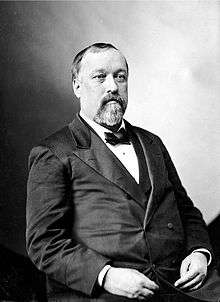
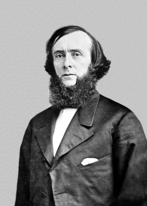
In 1874, Grant replaced Richardson as Treasury Secretary with Benjamin H. Bristow, a man known for his honesty,[302] who began a series of reforms in the department, including tightening up the detective force and firing the second-comptroller for inefficiency.[303] Discovering that millions of gallons of whiskey escaped taxation,[304] and having Grant's endorsement to act ("Let no guilty man escape"), Bristow in May 1875 struck down the Whiskey Ring, seizing 32 installations, impounding documents, and arresting some 350 men while obtaining 176 indictments.[305] These led to 110 convictions and $3,150,000 in tax dollars was restored to the Treasury.[306][307] When Bristow's investigation implicated Babcock as part of the Whiskey Ring, Grant became defensive, believing Babcock was the innocent victim of a witch hunt.[308] While denying immunity to minor Whiskey Ring conspirators, Grant worked to protect Babcock.[306] In 1876, a jury acquitted Babcock at a trial influenced by Grant's deposition in Babcock's favor.[309] After the trial, under public pressure, Grant dismissed Babcock from the White House.[310][lower-alpha 9] Grant pardoned some Ring members after a few months in prison, and pardoned Ring founder John McDonald after 17 months in jail.[306]

As the scandals increased, Congress, with the House now under Democratic control, began several investigations into corruption in the administration, the most notable of which dealt with profiteering at western trading posts involving Secretary of War William W. Belknap, which led to his resignation.[312] Congress also investigated and reprimanded Navy Secretary George M. Robeson in 1876 for receiving bribes.[313] Grant's Civil Service Commission reforms had limited success, as some members of his cabinet implemented a merit system that increased the number of qualified candidates and relied less on Congressional patronage.[314] Delano, however, exempted his department from competitive examinations, and Congress refused to enact permanent Civil Service reform.[315] Zachariah Chandler, who succeeded Delano, made sweeping reforms in the entire Interior Department; Grant ordered Chandler to fire all corrupt clerks in the Bureau of Indian Affairs.[316] In 1875, Grant fired Attorney General George Henry Williams after his wife was discovered to be involved in a bribery scandal, and appointed reformer Edwards Pierrepont in his place.[317] Bristow and Pierrepont teamed up and became Grant's executive anti-corruption team. [317] Postmaster Marshall Jewell using the postal department supported Bristow's investigations into the Whiskey Ring. [318] Pierrepont cleaned up corruption among the United States Attorneys and Marshals in the South.[319] Grant suggested other reforms as well, including a proposal that states should offer free public schooling to all children; he also endorsed the Blaine Amendment, which would have forbidden government aid to schools with religious affiliations.[320] In November 1876, Grant apologized to the nation and admitted mistakes in his administration, saying, "[f]ailures have been errors of judgement, not of intent."[321]
Election of 1876
Even as Grant drew cheers at the opening of the Centennial Exposition in May 1876, the collected scandals of his presidency, the country's weak economy, and the Democratic gains in the House led many in the Republican party to repudiate him in June.[322] Bristow was among the leading candidates to replace him, suggesting that a large faction desired an end to "Grantism" and feared that Grant would run for a third term.[323] Ultimately, Grant declined to run, but Bristow also failed to capture the nomination, as the convention settled on Governor Rutherford B. Hayes of Ohio, a reformer.[324] The Democrats nominated Governor Samuel J. Tilden of New York.[325] Voting irregularities in three Southern states caused the election that year to remain undecided for several months.[326] Grant told Congress to settle the matter through legislation and assured both sides that he would not use the army to force a result, except to curb violence.[327] On January 29, 1877, Grant signed legislation passed by Congress to form an Electoral Commission to decide the matter.[328] The result was the Compromise of 1877: the Electoral Commission ruled that the disputed votes belonged to Hayes, but the last troops were withdrawn from Southern capitals.[329] The Republicans had won, but Reconstruction was over.[329] According to biographer Jean Edward Smith, "Grant's calm visage in the White House reassured the nation."[330]
Cabinet
| The Grant Cabinet | ||
|---|---|---|
| Office | Name | Term |
| President | Ulysses S. Grant | 1869–1877 |
| Vice President | Schuyler Colfax | 1869–1873 |
| Henry Wilson | 1873–1875 | |
| None | 1875–1877 | |
| Secretary of State | Elihu B. Washburne | 1869 |
| Hamilton Fish | 1869–1877 | |
| Secretary of Treasury | George S. Boutwell | 1869–1873 |
| William A. Richardson | 1873–1874 | |
| Benjamin H. Bristow | 1874–1876 | |
| Lot M. Morrill | 1876–1877 | |
| Secretary of War | John A. Rawlins | 1869 |
| William W. Belknap | 1869–1876 | |
| Alphonso Taft | 1876 | |
| J. Donald Cameron | 1876–1877 | |
| Attorney General | Ebenezer R. Hoar | 1869–1870 |
| Amos T. Akerman | 1870–1871 | |
| George H. Williams | 1871–1875 | |
| Edwards Pierrepont | 1875–1876 | |
| Alphonso Taft | 1876–1877 | |
| Postmaster General | John A. J. Creswell | 1869–1874 |
| James W. Marshall | 1874 | |
| Marshall Jewell | 1874–1876 | |
| James N. Tyner | 1876–1877 | |
| Secretary of the Navy | Adolph E. Borie | 1869 |
| George M. Robeson | 1869–1877 | |
| Secretary of the Interior | Jacob D. Cox | 1869–1870 |
| Columbus Delano | 1870–1875 | |
| Zachariah Chandler | 1875–1877 | |
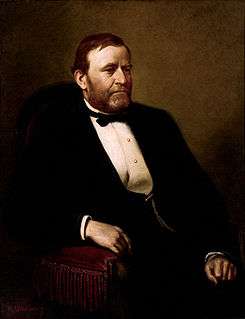
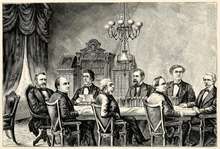
Post-presidency
World tour and diplomacy

After leaving the White House, Grant and his family stayed with Hamilton Fish and family in New York for two months before setting out on a world tour.[331] Preparing for the tour, Grant arrived in Philadelphia on May 10, 1877, staying with close friend George William Childs, and was honored with celebrations during the week before his departure.[332][333] On May 16, Grant embarked from Philadelphia to England aboard the SS Indiana.[334][335] Grant's tour was initially planned as a private affair with no set duration[335] but assumed diplomatic proportions when the Hayes administration, aware of Grant's popularity in Europe, encouraged him to extend his tour and voyage around the world to strengthen American interests abroad, an unprecedented undertaking for a former President.[336] The first stop of the journey was in Liverpool in May, where enormous crowds greeted the ex-president and his entourage.[337] Grant was lauded as the "Hero of Appomattox" and the Union general who defeated the Confederacy.[338] The Grants dined with Queen Victoria at Windsor Castle, and Grant gave several speeches in London.[339] After a tour on the continent, including Switzerland, the Grants visited Scotland, afterward spending time with their daughter Nellie, who had married an Englishman and lived in Southampton. Grant and his wife then journeyed to Paris and Italy, spending Christmas 1877 aboard USS Vandalia, a warship docked in Palermo.[340] After cruising the Mediterranean, the Grants took a winter sojourn through Egypt and the Holy Land followed by a visit to Greece, before returning to Italy and a meeting with Pope Leo XIII.[341] In 1878, they toured the Netherlands before moving on to Germany, where Grant discussed military matters with Chancellor Otto von Bismarck, telling him that in the final stages of the Civil War, the Union Army fought to preserve the nation and to "destroy slavery".[342] In Russia, Czar Alexander II talked to Grant about the future of the Plains Indians.[343] After touring Spain and revisiting Paris, the Grants returned to England.[344] From England, the Grants left by private ship, sailing into the Mediterranean and stopping at Marseilles, then across to Alexandria visiting Egypt hurriedly and on through the Suez Canal to India. They visited cities throughout the Raj, welcomed by colonial officials.[345]
Grant initially viewed British colonization of India as "purely selfish", yet upon observation, he acknowledged that the colonial subjects were allowed to prosper.[346] After India, they toured Burma, Siam (where Grant met with King Chulalongkorn), Singapore, and Cochinchina (Vietnam).[347] Leaving Hong Kong, the Grants visited Canton, Shanghai, and Peking, China, where he criticized the autocratic attitude of Westerners toward the Chinese, which he compared to that of antebellum slaveowners.[348] He declined to ask for an interview with the Guangxu Emperor, a child of seven, but did speak with the head of government, Prince Gong, and Li Hongzhang, a leading general.[349] They discussed China's dispute with Japan over the Ryukyu Islands, and Grant agreed to serve as a mediator desiring to bring the two sides to agreement.[350] After crossing over to Japan on the USS Richmond and meeting the Emperor Meiji, Grant, keeping his word, made diplomatic efforts to convince Japan to make peace with the Chinese, however, Japan having the military superiority, annexed the disputed Ryuku Islands, a few weeks after Grant left the country. [351][352]
Homesick, the Grants left Japan sailing on the City of Tokio escorted by a Japanese man-of-war, crossed the Pacific and landed in San Francisco in September 1879, greeted by cheering crowds.[353] After a visit to Yosemite Valley, they returned at last to Philadelphia on December 16, 1879. [354] Their two-year and seven-month voyage around the world captured the popular imagination, and Republicans—especially those of the Stalwart faction excluded from the Hayes administration—saw Grant in a new light.[355] The Republican nomination for 1880 was wide open after Hayes forswore a second term and many Republicans thought that Grant was the man for the job.[355]
Third term attempt
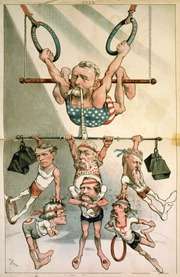
Stalwarts, led by Grant's old political ally, Roscoe Conkling, saw the ex-president's renewed popularity as a way for their faction to regain power. Opponents denounced the idea as a violation of the two-term rule that had been the norm since George Washington. Grant said nothing publicly, but he wanted the job and encouraged his men.[356] Elihu B. Washburne urged him to run; Grant demurred, saying he would be happy for the Republicans to win with another candidate, though he preferred James G. Blaine to John Sherman.[357] Even so, Conkling and John A. Logan began to organize delegates in Grant's favor. When the convention convened in Chicago in June, there were more delegates pledged to Grant than to any other candidate, but he was still short of a majority vote to capture the nomination.[357]
At the convention, Conkling nominated Grant with an elegant speech, the most famous line being: "When asked which state he hails from, our sole reply shall be, he hails from Appomattox and its famous apple tree."[357] With 370 votes needed for nomination, the first ballot had Grant at 304, Blaine at 284, Sherman at 93, and the rest scattered to minor candidates.[358] Subsequent ballots followed, with roughly the same result; neither Grant nor Blaine could win. After thirty-six ballots, Blaine's delegates deserted him and combined with those of other candidates to nominate a compromise candidate: Representative James A. Garfield of Ohio.[359] The 306 votes Grant received on the last ballot was not enough to secure the nomination. A procedural motion made the vote unanimous for Garfield, who accepted the nomination.[360]
Grant gave speeches for Garfield but declined to criticize the Democratic nominee, Winfield Scott Hancock, a general who had served under him in the Army of the Potomac.[361] Garfield won the popular vote by a narrow margin, but solidly won the Electoral College—214 to 155. After the election, Grant gave Garfield his public support, and pushed him to include Stalwarts in his administration.[362]
Business ventures
Grant's world tour had been costly. When he returned to America, Grant had depleted most of his savings and needed to earn money and find a new home.[363] Wealthy friends bought him a home on Manhattan's Upper East Side, and to make an income, Grant, Jay Gould, and former Mexican Finance Secretary Matías Romero chartered the Mexican Southern Railroad, with plans to build a railroad from Oaxaca to Mexico City.[364] Grant urged Chester A. Arthur, who had succeeded Garfield as president in 1881, to negotiate a free trade treaty with Mexico. Arthur and the Mexican government agreed, but the United States Senate rejected the treaty in 1883.[364] The railroad was similarly unsuccessful, falling into bankruptcy the following year.[364]
At the same time, Grant's son Ulysses Jr. had opened a Wall Street brokerage house with Ferdinand Ward. Regarded as a rising star, Ward, and the firm, Grant & Ward, were initially successful.[365] In 1883, Grant joined the firm and invested $100,000 of his own money.[366] To encourage investment, Ward paid investors abnormally high interest, by pledging the company's securities on multiple loans in a process called rehypothecation. [365][367] Ward, in collusion with banker James D. Fish, kept secret from regulators, retrieved the firm's securities from the company's bank vault.[368] When the trades went bad, multiple loans came due, all backed up by the same collateral. Historians agree that Grant was likely unaware of Ward's intentions, but it is unclear how much Buck Grant knew. In May 1884, enough investments went bad to convince Ward that the firm would soon be bankrupt. Ward told Grant of the impending failure, but assured Grant that this was a temporary shortfall.[369][368] Grant approached businessman William Henry Vanderbilt, who gave him a personal loan of $150,000.[370] Grant invested the money in the firm, but it was not enough to save it from failure. Essentially penniless, but compelled by a sense of personal honor, he repaid what he could with his Civil War mementos and the sale or transfer of all other assets.[371] Vanderbilt took title to Grant's home, although he allowed the Grants to continue to reside there, and pledged to donate the souvenirs to the federal government.[372] The proceeds did not cover the loan but Vanderbilt insisted the debt had been paid in full; Grant was left destitute.[369] Grant was distraught over Ward's deception and asked privately how he could ever "trust any human being again."[373] Grant was never charged, and in March 1885, with his health beginning to fail, he testified against both Ward and Fish.[374][375] Ward was convicted of fraud in October 1885, months after Grant's death, and served six and a half years in prison.[369]
Memoirs, pension, and death
To restore his family's income and reputation, Grant wrote several articles on his Civil War campaigns for The Century Magazine at $500 each. The articles were well received by critics, and the editor, Robert Underwood Johnson, suggested that Grant write a book of memoirs, as Sherman and others had done. Grant's articles would serve as the basis for several chapters.[376]
In the summer of 1884, Grant complained of a soreness in his throat, but put off seeing a doctor until late October where he finally learned it was throat cancer.[377] Before being diagnosed, Grant was invited to a Methodist service for Civil War veterans in Ocean Grove, New Jersey, on August 4, 1884, receiving a standing ovation from more than ten thousand veterans and others; it would be his last public appearance.[378] In March of the following year, the New York Times finally announced that Grant was dying of cancer[379] and a nationwide public concern for the former president began.[380][lower-alpha 10][382] In March 1885, knowing Grant was dying, Congress restored him to the rank of General of the Army with full retirement pay.[382][383] Grant's assumption of the Presidency in 1869 had required that he resign his military commission and forfeit his pension.[382][383]
Despite his debilitating illness, Grant worked diligently on his memoirs at his home in New York City, and then from a cottage on the slopes of Mount McGregor, finishing only days before he died.[384] Grant asked his former staff officer, Adam Badeau, to help edit his work. Grant's son Fred assisted with references and proofreading. Century magazine offered Grant a book contract with a 10 percent royalty, but Grant accepted a better offer from his friend, Mark Twain, who proposed a 75 percent royalty.[385] His memoir ends with the Civil War, and does not cover the post-war years, including his presidency.[386]
The book, Personal Memoirs of Ulysses S. Grant, was a critical and commercial success. In the end, Julia Grant received about $450,000 in royalties.[385] The memoir has been highly regarded by the public, military historians, and literary critics.[387] Grant portrayed himself in the persona of the honorable Western hero, whose strength lies in his honesty and straightforwardness. He candidly depicted his battles against both the Confederates and internal army foes.[388] Twain called the Memoirs a "literary masterpiece." Given over a century of favorable literary analysis, reviewer Mark Perry states that the Memoirs are "the most significant work" of American non-fiction.[389] Grant's successful autobiography pioneered a method for ex-presidents and veterans to earn money. [390]
In the days preceding his death, Grant's wife, Julia, all of his children, and three grandchildren were present. After a year-long struggle with the cancer, Grant died at 8 o'clock in the morning in the Mount McGregor cottage on July 23, 1885, at the age of 63.[391] Sheridan, then Commanding General of the Army, ordered a day-long tribute to Grant on all military posts, and President Grover Cleveland ordered a thirty-day nationwide period of mourning. After private services, the honor guard placed Grant's body on a special funeral train, which traveled to West Point and New York City. A quarter of a million people viewed it in the two days before the funeral.[392] Tens of thousands of men, many of them veterans from the Grand Army of the Republic (GAR) or other veterans' organizations, marched with Grant's casket drawn by two dozen horses to Riverside Park in the Morningside Heights neighborhood of Upper Manhattan, New York City.[392] His pallbearers included Union generals Sherman and Sheridan, Confederate generals Simon Bolivar Buckner and Joseph E. Johnston, Admiral David Dixon Porter, and Senator John A. Logan, the head of the GAR.[392] Following the casket in the seven-mile-long procession were President Cleveland, the two living former presidents Hayes and Arthur, all of the President's Cabinet, as well as the justices of the Supreme Court.[393][394]
Grant's body was laid to rest in Riverside Park, first in a temporary tomb, and then—twelve years later, on April 17, 1897—in the General Grant National Memorial, also known as "Grant's Tomb". The tomb is the largest mausoleum in North America. Attendance at the New York funeral topped 1.5 million.[392] Ceremonies were held in other major cities around the country, and those who eulogized Grant in the press likened him to George Washington and Abraham Lincoln.[395]
Historical reputation
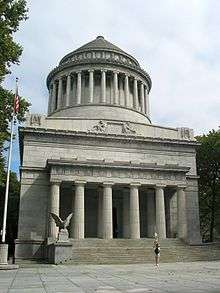
No presidential reputations have changed as dramatically as Grant's.[396] Hailed across the North as the winning general in a great war, his nomination as president seemed inevitable. Grant's popularity declined with congressional investigations into corruption in his administration and Custer's defeat at the Battle of the Little Big Horn. In 1877, there was bipartisan approval of Grant's peaceful handling of the electoral crisis.[397] Grant's reputation soared during his well-publicized world tour.[398]
At his death, Grant was seen as "a symbol of the American national identity and memory", when millions turned out for his funeral procession in 1885 and attended the 1897 dedication of his tomb.[399] Grant's popularity increased in the years immediately after his death. At the same time, commentators and scholars portrayed his administration as the most corrupt in American history. As the popularity of the pro-Confederate Lost Cause movement increased early in the 20th century, a more negative view became increasingly common.[400] As they had early in the Civil War, Grant's new critics charged that he was a reckless drunk, and in light of his presidency, that he was also corrupt. In the 1930s, biographer William B. Hesseltine noted that Grant's reputation deteriorated because his enemies were better writers than his friends.[401] In 1931, Frederic Paxson and Christian Bach in the Dictionary of American Biography praised Grant's military vision and his execution of that vision in defeating the Confederacy, but of his political career, the authors were less complimentary. Speaking specifically of the scandals, they wrote that "personal scandal has not touched Grant in any plausible form, but it struck so close to him and so frequently as to necessitate the vindication of his honor by admitting his bad taste in the choice of associates."[402]
Views of Grant reached new lows as he was seen as an unsuccessful president and an unskilled, if lucky, general.[398] Bruce Catton and T. Harry Williams began the reassessment of Grant's military career in the 1960s, shifting the analysis of Grant as victor by brute force to that of successful and skillful strategist and commander.[403] Even for scholars with a particular concern for the plight of former slaves and Indians, Grant left a problematic legacy and, with changing attitudes toward warfare after the end of the Vietnam War, Grant's military reputation suffered again.[404] William S. McFeely won the Pulitzer Prize for his critical 1981 biography that emphasized the failure of Grant's presidency to carry out lasting progress and concluded that "he did not rise above limited talents or inspire others to do so in ways that make his administration a credit to American politics."[405] John Y. Simon in 1982 responded to McFeely: "Grant's failure as President ... lies in the failure of the Indian peace policy and the collapse of Reconstruction ... But if Grant tried and failed, who could have succeeded?"[406] Simon praised Grant's first term in office, arguing that it should be "remembered for his staunch enforcement of the rights of freedmen combined with conciliation of former Confederates, for reform in Indian policy and civil service, for successful negotiation of the Alabama Claims, and for delivery of peace and prosperity."[407] According to Simon, the Liberal Republican revolt, the Panic of 1873, and the North's conservative retreat from Reconstruction weakened Grant's second term in office, although his foreign policy remained steady.[407]
Historians' views have grown more favorable since the 1990s, appreciating Grant's protection of African Americans and his peace policy towards Indians, even where those policies failed.[399] Grant's reputation rose further with Jean Edward Smith's 2001 biography. Smith argued that the same qualities that made Grant a success as a general carried over to his political life to make him, if not a successful president, then certainly an admirable one.[408] Smith wrote that "the common thread is strength of character—an indomitable will that never flagged in the face of adversity ... Sometimes he blundered badly; often he oversimplified; yet he saw his goals clearly and moved toward them relentlessly."[409] Brooks Simpson continued the trend in the first of two volumes on Grant in 2000, although the work was far from a hagiography.[410] H. W. Brands, in his more uniformly positive 2012 book, wrote favorably of Grant's military and political careers alike, saying:
As commanding general in the Civil War, he had defeated secession and destroyed slavery, secession's cause. As President during Reconstruction he had guided the South back into the Union. By the end of his public life the Union was more secure than at any previous time in the history of the nation. And no one had done more to produce the result than he.[411]
As Reconstruction scholar Eric Foner wrote, Brands gave "a sympathetic account of Grant's forceful and temporarily successful effort as president to crush the Ku Klux Klan, which had inaugurated a reign of terror against the former slaves."[396] Foner criticized Grant for not sending military aid to Mississippi during the 1875 election to protect African Americans from threats of violence.[396] According to Foner, "Grant's unwillingness to act reflected the broader Northern retreat from Reconstruction and its ideal of racial equality."[396][lower-alpha 11]
According to historian Brooks Simpson, Grant was on "the right side of history".[413] Simpson said, "[w]e now view Reconstruction ... as something that should have succeeded in securing equality for African-Americans, and we see Grant as supportive of that effort and doing as much as any person could do to try to secure that within realm of political reality."[413] John F. Marszalek said, "You have to go almost to Lyndon Johnson to find a president who tried to do as much to ensure black people found freedom."[413] In 2016, a biography by Ronald C. White continued this trend in Grant scholarship with an account that historian T. J. Stiles said "solidifies the positive image amassed in recent decades, blotting out the caricature of a military butcher and political incompetent engraved in national memory by Jim Crow era historians."[414]
Besides civil rights, issues of environmental protection have also attracted historiographical attention. Historian Joan Waugh, in her generally favorable book, says Grant appreciated the beauty of the West, and in 1872 signed the law establishing the country's first national park at Yellowstone. However, she argues:
... he approved of projects that took great swaths of land and opened them to timber, cattle, land speculators, and millions of settlers ... the idea of preserving the region's environment and concerns about industrial pollution were of much less importance to Grant ... [415]
Throughout the 20th century, historians ranked his presidency near the bottom. In the 21st century, his military reputation is strong, while most scholars rank his presidency well below average.[396] His accomplishments as President have been overlooked due to corruption charges of his Cabinet members and appointees during his administration.[416] Concerning his post-presidential trip around the world, historian Edwina S. Campbell said that Grant "invented key aspects of the foreign-policy role of the modern American presidency, and created an image abroad of the United States that endures to this day."[417]
Memorials and presidential library
Several memorials honor Grant. In addition to his mausoleum, the General Grant National Memorial in New York, there is the Ulysses S. Grant Memorial at the foot of Capitol Hill in Washington, D.C.[418] Dedicated in 1922, it overlooks the Capitol Reflecting Pool and is made of bronze and marble created by sculptor Henry Merwin Shrady and architect Edward Pearce Casey.[419] On April 23, 2015, the 193rd anniversary of Grant's birth, restoration work began; the restoration is expected to be completed before the bicentennial of Grant's birth in 2022.[420]
The Ulysses S. Grant National Historic Site near St. Louis, and several other sites in Ohio and Illinois memorialize Grant's life.[421] There are smaller memorials in Chicago's Lincoln Park and Philadelphia's Fairmount Park. Named in his honor are Grant Park, as well as several counties in western and midwestern states. On June 3, 1891, a bronze statue of Grant, created by Danish sculptor Johannes Gelert and commissioned by publisher H. H. Kohlsaat, was dedicated at Grant Park in Galena, Illinois.[422] [423] From 1890 to 1940, part of what is now Kings Canyon National Park was called General Grant National Park, named for the General Grant sequoia.[424] Grant has appeared on the front of the United States fifty-dollar bill since 1913. In 1921, the Ulysses S. Grant Centenary Association was founded whose goal was to coordinate special observances and create monuments in recognition of Grant’s historical role. To finance this venture the group proposed a bill authorizing the minting of up to 200,000 gold dollars, but it was amended and only 10,000 gold dollars were minted along with 250,000 half dollars (depicted below). The bill was passed on February 2, 1922. The coins were minted and issued in 1922, commemorating the 100th anniversary of Grant's birth.[425][426] Grant has also appeared on several U.S. postage stamps, the first one issued in 1890, five years after Grant's death.[427]
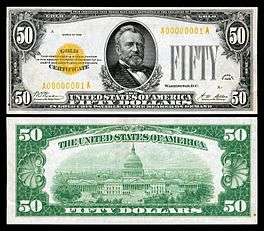
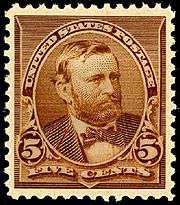
In May 2012, the Ulysses S. Grant Foundation, on the institute's fiftieth anniversary, selected Mississippi State University as the permanent location for Ulysses S. Grant's presidential library.[428] Historian John Y. Simon edited Grant's letters into a 32-volume scholarly edition published by Southern Illinois University Press.[429]
See also
- Gallery of images of Ulysses S. Grant
- List of American Civil War battles
- List of American Civil War generals
Notes
- ↑ One biographer, Edward G. Longacre, attributes Grant's parents' decision to their recognition of his hatred of music.[5]
- ↑ According to Grant, the S. did not stand for anything, though Hamer had used it to stand for Simpson, Grant's mother's maiden name.[14]
- ↑ The Republicans kept the name "Union" on their ticket as had been done earlier at their 1864 convention.[172]
- ↑ Residents of Galena gave Grant the home in 1865 as thanks for his war service.[176] After his presidential term ended in 1877, Grant visited the home occasionally. Maintenance of the home as a memorial to Grant started in 1904 and continues today.[177]
- ↑ In 1876, two decisions of the Supreme Court of the United States (United States v. Reese and United States v. Cruikshank) also did much to undermine Reconstruction-era laws that protected the rights of black Americans. Grant nominee Morrison Waite wrote the court's opinions joined by others, while another Grant nominee Ward Hunt dissented.[194]
- ↑ The international tribunal awarded the United States $15,500,000.[247]
- ↑ Greeley died after election day but before the day the Electoral College voted, as a result, Greeley's running mate, Benjamin Gratz Brown, received most of the electoral votes Greeley would have had.[279]
- ↑ Grant and Delano, his second Secretary of Interior, were third cousins.[289]
- ↑ McFeely, writing in 1981, believed that Grant knew of Babcock's guilt, while Smith, in 2001, believed the evidence against Babcock was circumstantial at best.[311]
- ↑ Today, medical historians believed he suffered from a T1N1 carcinoma of the tonsillar fossa.[381]
- ↑ In 1883, the U.S. Supreme Court overruled the Civil Rights Act of 1875 that guaranteed African Americans "full and equal enjoyment of the accommodations, advantages, facilities and privileges"; the ruling setting up a legal foundation for Jim Crow segregation throughout the South until the 1960's.[412]
References
- ↑ Bonekemper 2004, pp. 271–282.
- ↑ McFeely 1981, p. 3.
- ↑ Smith 2001, pp. 21–22.
- ↑ Hesseltine 1957, p. 4.
- 1 2 Longacre 2006, pp. 6–7.
- ↑ McFeely 1981, p. 497.
- ↑ Paxson & Bach 1931, p. 492.
- 1 2 Waugh 2009, p. 10.
- ↑ Simpson 2000, pp. 2–3; Longacre 2006, pp. 6–7.
- ↑ McFeely 1981, pp. 8, 10, 140–41.
- ↑ Simon 1967, p. 363.
- ↑ White 2016, p. 25.
- ↑ White 2016, pp. 25, 43.
- 1 2 McFeely 1981, p. 12; Smith 2001, pp. 24, 83.
- ↑ McFeely 1981, p. 16; Smith 2001, pp. 26–28.
- ↑ McFeely 1981, p. 20; Longacre 2006, p. 18.
- ↑ Wilson Quarterly 2015, pp. 11–12.
- ↑ McFeely 1981, pp. 16, 19.
- ↑ Smith 2001, pp. 26–28; Longacre 2006, p. 24.
- ↑ Smith 2001, pp. 28–29; Brands 2012a, p. 15.
- ↑ Smith 2001, p. 28.
- 1 2 Smith 2001, pp. 30–33.
- ↑ McFeely 1981, pp. 20, 26; Bonekemper 2011, p. 8.
- ↑ Smith 2001, p. 73.
- ↑ Smith 2001, pp. 35–37; Brands 2012a, pp. 15–17.
- ↑ Brands 2012a, p. 23.
- ↑ McFeely 1981, pp. 32–33.
- ↑ Smith 2001, pp. 56–57.
- ↑ McFeely 1981, pp. 34–35.
- ↑ Brands 2012a, pp. 41–42.
- 1 2 McFeely 1981, p. 36.
- ↑ McFeely 1981, p. 36; Brands 2012a, p. 43.
- ↑ Simpson 2000, p. 44.
- ↑ Smith 2001, pp. 67–68, 70, 73; Brands 2012a, p. 49.
- ↑ Simpson 2000, p. 458.
- ↑ McFeely 1981, pp. 31, 37.
- ↑ McFeely 1981, p. 44.
- 1 2 Smith 2001, pp. 76–77.
- ↑ McFeely 1981, p. 47.
- ↑ Brands 2012a, p. 62.
- ↑ McFeely 1981, pp. 48–49.
- ↑ McFeely 1981, p. 52.
- ↑ Smith 2001, p. 86.
- ↑ Longacre 2006, pp. 55–58.
- 1 2 McFeely 1981, p. 55.
- ↑ Smith 2001, pp. 87–88; Lewis 1950, pp. 328–332.
- ↑ Brands 2012a, pp. 77–78.
- 1 2 3 4 McFeely 1981, pp. 58–60.
- ↑ McFeely 1981, p. 61.
- 1 2 Smith 2001, pp. 94–95.
- ↑ McFeely 1981, p. 62.
- ↑ McFeely 1981, p. 69.
- ↑ McFeely 1981, p. 64.
- ↑ McFeely 1981, pp. 65–66.
- 1 2 3 4 Simon 1969, pp. 4–5.
- 1 2 McFeely 1981, pp. 69–70.
- ↑ Brands 2012a, p. 95.
- 1 2 Brands 2012a, p. 121.
- ↑ McFeely 1981, pp. 73–76, 80; Smith 2001, pp. 107–108; Brands 2012a, p. 121.
- ↑ McFeely 1981, p. 73.
- ↑ Brands 2012a, p. 123.
- ↑ McFeely 1981, p. 80.
- ↑ Flood 2005, p. 43.
- ↑ McFeely 1981, p. 81.
- ↑ Flood 2005, pp. 45–46.
- ↑ Smith 2001, p. 113.
- ↑ Smith 2001, pp. 117–118; Catton 1963, p. 29.
- ↑ Flood 2005, p. 63.
- ↑ Brands 2012a, p. 151; Flood 2005, p. 71; Smith 2001, p. 131.
- ↑ McFeely 1981, pp. 92–94.
- ↑ Smith 2001, pp. 138–142.
- ↑ Smith 2001, pp. 141–164; Brands 2012a, pp. 164–165.
- ↑ Brands 2012a, pp. 164–165; Smith 2001, pp. 125–134.
- ↑ McFeely 1981, p. 111.
- ↑ Bonekemper 2012, pp. 51, 94.
- ↑ Bonekemper 2012, pp. 51, 58–59, 63–64.
- ↑ McFeely 1981, p. 114; Flood 2005, pp. 109, 112.
- ↑ Bonekemper 2012, p. 63.
- ↑ Bonekemper 2012, pp. 59, 63–64.
- ↑ Kaplan 2015, pp. 1109–1119.
- ↑ Bonekemper 2012, p. 94.
- ↑ Brands 2012a, pp. 188–191.
- ↑ Longacre 2006, p. 137.
- ↑ Brands 2012a, pp. 211–212.
- ↑ Badeau 1887, p. 126.
- ↑ Flood 2005, p. 133.
- ↑ Catton 1960, p. 112.
- ↑ Brands 2012a, pp. 221–223.
- ↑ Flood 2005, pp. 147–148.
- ↑ Catton 1960, pp. 119, 291.
- ↑ Brands 2012a, pp. 223, 225.
- ↑ Bonekemper 2012, pp. 147–148.
- ↑ Smith 2001.
- ↑ Flood 2005, pp. 143–144; Sarna 2012a, p. 37.
- ↑ Brands 2012a, p. 218.
- ↑ Sarna 2012b; Smith 2001, p. 225.
- ↑ Smith 2001, pp. 226–227; Simpson 2000, pp. 164–165; Brands 2012a, pp. 217–219.
- ↑ Brands 2012a, p. 220; Smith 2001, pp. 226–227.
- ↑ Smith 2001, pp. 226–227.
- ↑ Ash 2010, p. 368.
- ↑ Sarna 2012a, pp. 89, 147.
- ↑ Bonekemper 2012, pp. 148–149.
- ↑ Brands 2012a, pp. 226–228.
- ↑ Flood 2005, p. 160.
- ↑ Flood 2005, pp. 164–165.
- ↑ McFeely 1981, pp. 122–138; Smith 2001, pp. 206–257.
- ↑ Catton 1968, p. 8.
- ↑ McFeely 1981, pp. 128, 135.
- ↑ McFeely 1981, p. 136.
- ↑ Catton 1968, p. 7.
- ↑ Newell & Shrader 2011, p. 28.
- ↑ Brands 2012a, p. 265.
- ↑ Flood 2005, p. 196.
- ↑ Flood 2005, p. 201.
- ↑ Brands 2012a, p. 267; McFeely 1981, p. 145.
- ↑ Brands 2012a, pp. 267–268.
- ↑ McFeely 1981, p. 147; Smith 2001, pp. 267–268; Catton 1968, pp. 46, 54.
- 1 2 Flood 2005, pp. 214–215.
- ↑ Flood 2005, p. 216.
- ↑ Flood 2005, pp. 217–218.
- ↑ McFeely 1981, pp. 148–150.
- ↑ Flood 2005, p. 232; McFeely 1981, p. 148.
- ↑ McFeely 1981, p. 156.
- ↑ Catton 1960, pp. 190, 193.
- ↑ McFeely 1981, p. 157.
- ↑ McFeely 1981, pp. 157–175; Smith 2001, pp. 313–339, 343–368.
- 1 2 McFeely 1981, pp. 162–163.
- ↑ McFeely 1981, p. 165.
- ↑ McFeely 1981, p. 169.
- ↑ Bonekemper 2011, pp. 41–42.
- ↑ McFeely 1981, pp. 157–175; Smith 2001, pp. 313–39, 343–68.
- ↑ McFeely 1981, pp. 178–186.
- ↑ McFeely 1981, p. 179; Smith 2001, pp. 369–395; Catton 1968, pp. 308–309.
- ↑ Catton 1968, p. 349.
- ↑ Catton 1968, p. 309.
- ↑ Catton 1968, p. 294.
- ↑ Catton 1960, pp. 223, 228.
- ↑ Catton 1960, p. 235.
- ↑ McFeely 1981, pp. 198–210.
- ↑ McFeely 1981, pp. 213–214.
- ↑ Goethals 2015, p. 92.
- ↑ Catton 1960, p. 304.
- ↑ McFeely 1981, pp. 212, 219–220; Catton 1960, p. 304.
- ↑ McFeely 1981, p. 224.
- ↑ Brands 2012a, pp. 375–376.
- ↑ Smith 2001, pp. 409–412.
- ↑ McFeely 1981, pp. 227–229.
- ↑ Brands 2012a, pp. 410–411.
- ↑ McFeely 1981, pp. 232–233.
- ↑ McFeely 1981, p. 234.
- ↑ Brands 2012a, p. 390; Smith 2001, p. 420; McFeely 1981, pp. 238–241.
- ↑ Brands 2012a, p. 390.
- ↑ McFeely 1981, pp. 238, 240.
- ↑ McFeely 1981, p. 240; Smith 2001, p. 420.
- ↑ McFeely 1981, pp. 240–241.
- ↑ Smith 2001, p. 434n.
- 1 2 3 Brands 2012a, pp. 397–398.
- ↑ Brands 2012a, pp. 392, 396.
- ↑ Brands 2012a, p. 396.
- ↑ Smith 2001, pp. 369–397; Brands 2012a, p. 389.
- ↑ Brands 2012a, pp. 398–399.
- ↑ Smith 2001, pp. 432–433.
- ↑ Smith 2001, pp. 434–435.
- ↑ Smith 2001, pp. 436–439.
- ↑ McFeely 1981, pp. 259–261.
- ↑ Smith 2001, pp. 421, 433.
- ↑ Smith 2001, p. 423, 424.
- ↑ Smith 2001, p. 438.
- ↑ McFeely 1981, pp. 262–264.
- 1 2 3 Smith 2001, pp. 448–451.
- ↑ McFeely 1981, p. 275.
- ↑ History of U.S. Political Parties, edited by Arthur Schlesinger (1973), Volume 2, 1860–1910, 2:1287
- ↑ McFeely 1981, pp. 264–267.
- ↑ Smith 2001, pp. 459–460.
- ↑ Sarna 2012a, pp. xi, 88–90, 101–3.
- ↑ Grant Home, Galena State Historic Sites. Retrieved February 9, 2007.
- ↑ Ulysses S. Grant Home, NHL Database, National Historic Landmarks Program. Retrieved February 9, 2007.
- ↑ McFeely 1981, pp. 282–284.
- ↑ Foner 2014, pp. 340, 344.
- ↑ Smith 2001, pp. 468–469.
- ↑ McFeely 1981, pp. 278, 283.
- ↑ Smith 2001, p. 461.
- ↑ McFeely 1981, p. 284.
- ↑ Foner 2014, pp. 243–244.
- 1 2 McFeely 1981, pp. 287–288.
- ↑ Patrick 1968, p. 166.
- ↑ McFeely 1981, p. 305.
- ↑ Smith 2001, pp. 465–466; McFeely 1981, pp. 286, 290.
- 1 2 Simon 2002, pp. 246–247.
- ↑ Smith 2001, pp. 477–478.
- ↑ McFeely 1981, pp. 293–294.
- ↑ Smith 2001, pp. 469–470.
- ↑ Smith 2001, pp. 507–508, 562–563.
- 1 2 McFeely 1981, pp. 387–389.
- ↑ Goethals 2015, p. 96.
- ↑ Kaczorowski 1995, p. 155.
- ↑ Brands 2012a, p. 435.
- 1 2 3 Brands 2012a, p. 465.
- ↑ Smith 2001, pp. 543–545.
- ↑ McFeely 1981, pp. 368–369; Brands 2012a, pp. 467, 470.
- ↑ Smith 2001, pp. 544–547.
- ↑ Kaczorowski 1995, p. 182.
- ↑ Wang 1997, p. 102.
- ↑ Rable 2007, pp. 144–186.
- ↑ Smith 2001, pp. 552–553.
- ↑ Kaczorowski 1995, p. 184.
- ↑ Brands 2012a, pp. 538–541; Foner 2014, p. 528.
- ↑ Nystrom 2010, p. 176; Foner 2014, p. 555.
- 1 2 Brands 2012a, p. 553.
- ↑ McFeely 1981, pp. 420–422.
- ↑ McFeely 1981, pp. 418–419.
- ↑ Brands 2012a, p. 570.
- ↑ Smith 2001, pp. 603–604.
- 1 2 3 White 2016, p. 551.
- 1 2 McFeely 1981, pp. 308–309; Brands 2012a, p. 502.
- ↑ Smith 2001, p. 535.
- ↑ Waltmann 1971, p. 327.
- ↑ Smith 2001, p. 541.
- ↑ Smith 2001, pp. 536–538; Brands 2012a, pp. 501–503.
- ↑ Brands 2012a, pp. 501–503; McFeely 1981, pp. 436–437.
- ↑ Smith 2001, pp. 532–535.
- 1 2 Donovan 2008, pp. 115, 322–323.
- ↑ Brands 2012a, pp. 565–566.
- 1 2 3 White 2016, p. 507.
- ↑ McFeely 1981, pp. 336–338; Brands 2012a, p. 452; White 2016, p. 507.
- ↑ White 2016; McFeely 1981, pp. 336–338; McFeely 1974, p. 137.
- ↑ Smith 2001, pp. 500–502; McFeely 1974, p. 137; White 2016, p. 508.
- ↑ Smith 2001, pp. 500–502; White 2016, p. 508.
- ↑ White 2016.
- ↑ Smith 2001, pp. 500–502.
- ↑ McFeely 1974, p. 139.
- ↑ Brands 2012a, pp. 455–456.
- ↑ McFeely 1981, pp. 339–341.
- ↑ White 2016, p. 509, 510.
- ↑ White 2016, p. 511.
- ↑ White 2016, p. 511-512.
- ↑ McFeely 1981, pp. 349–352.
- ↑ McFeely 1974, p. 138.
- ↑ Brands 2012a, p. 454.
- ↑ Brands 2012a, p. 461.
- ↑ Brands 2012a, p. 461; Smith 2001, pp. 505–506.
- ↑ McFeely 1981, pp. 334–336.
- ↑ Simon 2002, p. 249.
- ↑ McFeely 1981, pp. 352–354.
- ↑ Smith 2001, p. 508.
- ↑ Smith 2001, pp. 508–511.
- 1 2 Smith 2001, pp. 512–515.
- ↑ Nevins 1936, pp. 667–694.
- 1 2 Goethals 2015, p. 98.
- ↑ Friedman 1985, pp. 405–406.
- 1 2 Kreiser 2013, p. 19.
- ↑ McFeely 1981, p. 279.
- 1 2 Smith 2001, pp. 480–481.
- ↑ Smith 2001, p. 482.
- ↑ McFeely 1974, pp. 134–135.
- 1 2 Brands 2012a, pp. 437–443.
- 1 2 3 McFeely 1974, p. 134.
- ↑ McFeely 1981, pp. 323–324.
- ↑ McFeely 1974, p. 136.
- 1 2 Smith 2001, pp. 486–489.
- ↑ McFeely 1974, p. 135.
- ↑ Brands 2012a, pp. 445, 636.
- ↑ Smith 2001, p. 490.
- ↑ McFeely 1981, p. 328; Smith 2001, p. 490.
- ↑ Foner 2014, pp. 499–500.
- ↑ Foner 2014, p. 500–507.
- ↑ Patrick 1968, p. 172.
- 1 2 Simon 2002, p. 250.
- ↑ Smith 2001, pp. 589–590; Patrick 1968, p. 173.
- 1 2 Brands 2012a, pp. 488–489.
- ↑ Wang 1997, p. 103.
- ↑ Wang 1997, pp. 103–104.
- ↑ Brands 2012a, p. 494.
- ↑ Brands 2012a, p. 495.
- ↑ McFeely 1981, p. 381.
- ↑ Brands 2012a, pp. 508–509.
- ↑ Foner 2014, p. 509.
- ↑ McFeely 1981, p. 384.
- 1 2 Brands 2012a, p. 499.
- ↑ Foner 2014, p. 508.
- ↑ Venable 2011, pp. 66–68.
- ↑ Weinstein 1967, pp. 307–326.
- 1 2 Brands 2012a, p. 517.
- ↑ McFeely 1981, p. 393.
- 1 2 Smith 2001, pp. 576–579.
- ↑ Brands 2012a, p. 518.
- ↑ McFeely 1981, p. 391; Smith 2001, pp. 375–377.
- ↑ McFeely 1981, p. 395.
- ↑ Porter 2005, p. 185.
- 1 2 3 4 Smith 2001, pp. 580–581.
- ↑ White 2016, p. 550.
- 1 2 Woodward 1957, passim.
- ↑ White 2016, p. 541.
- 1 2 3 McFeely 1974, pp. 133–134.
- ↑ Smith 2001, p. 592; McFeely 1981, pp. 407–415; White 2016, pp. 538–539.
- ↑ Smith 2001, p. 587.
- ↑ McFeely 1974, pp. 171–175.
- ↑ Dalzell 2014.
- 1 2 Smith 2001, p. 578.
- ↑ McFeely 1974, p. 147.
- 1 2 McFeely 1974, pp. 147–148.
- ↑ McFeely 1974, p. 148.
- ↑ Brands 2012a, pp. 556–557; Kohn 2000, p. 417; Nevins 1929, p. 56.
- ↑ Brands 2012a, pp. 556–557.
- ↑ McFeely 1974, p. 156; Nevins 1929, p. 56; Smith 2001, p. 584.
- 1 2 3 Kohn 2000, p. 417.
- ↑ Nevins 1929, p. 56.
- ↑ Smith 2001, p. 591.
- ↑ Smith 2001, pp. 592–593.
- ↑ Smith 2001, pp. 591–593.
- ↑ McFeely 1981, p. 415; Smith 2001, p. 591.
- ↑ Brands 2012a, pp. 560–561; Donovan 2008, p. 104.
- ↑ McFeely 1974, p. 153.
- ↑ Smith 2001, pp. 589–590; Simon 2002, p. 250.
- ↑ Smith 2001, p. 589.
- ↑ Simon 2002, p. 250; Patrick 1968, p. 172.
- 1 2 White 2016, p. 557.
- ↑ Smith 2001, pp. 584–585; Hesseltine 1957, p. 366.
- ↑ Hesseltine 1957, p. 374.
- ↑ Smith 2001, pp. 570–571.
- ↑ McFeely 1981, pp. 441–442.
- ↑ McFeely 1981, pp. 440–441; Patrick 1968, p. 255.
- ↑ McFeely 1981, pp. 440–441.
- ↑ Smith 2001, pp. 586, 596.
- ↑ Smith 2001, p. 597.
- ↑ Smith 2001, p. 598.
- ↑ Smith 2001, pp. 601–603.
- ↑ Smith 2001, p. 602.
- 1 2 Smith 2001, p. 604.
- ↑ Smith 2001, p. 603.
- ↑ McFeely 1981, pp. 448–449.
- ↑ Young 1879a, p. 4.
- ↑ White 2016, p. 577.
- ↑ White 2016, p. 590.
- 1 2 Young 1879a, p. 5.
- ↑ Campbell 2016, pp. xi–xii, 2–3.
- ↑ McFeely 1981, pp. 454–455.
- ↑ Smith 2001, p. 608.
- ↑ Brands 2012a, pp. 581–583.
- ↑ McFeely 1981, pp. 460–465.
- ↑ McFeely 1981, pp. 466–467.
- ↑ Brands 2012a, pp. 585–586.
- ↑ Brands 2012a, p. 608.
- ↑ White 2016, p. 589.
- ↑ McFeely 1981, pp. 471–473.
- ↑ McFeely 1981, pp. 473–474.
- ↑ Brands 2012a, pp. 590–591.
- ↑ Smith 2001, p. 612.
- ↑ Brands 2012a, pp. 591–592.
- ↑ Brands 2012a, pp. 593–594.
- ↑ Smith 2001, pp. 612n–613n.
- ↑ White 2016, pp. 611–612.
- ↑ Smith 2001, p. 613.
- ↑ McFeely 1981, p. 477.
- 1 2 Smith 2001, pp. 614–615.
- ↑ Hesseltine 1957, pp. 432–439.
- 1 2 3 Brands 2012a, pp. 600–601.
- ↑ McFeely 1981, pp. 479–481.
- ↑ Brands 2012a, p. 602.
- ↑ Smith 2001, p. 617.
- ↑ Brands 2012a, pp. 604–605.
- ↑ Brands 2012a, pp. 607–609.
- ↑ Brands 2012a, p. 611.
- 1 2 3 McFeely 1981, pp. 486–489.
- 1 2 McFeely 1981, pp. 488–491.
- ↑ Brands 2012a, p. 619.
- ↑ White 2016, p. 269.
- 1 2 White 2016, pp. 627,629.
- 1 2 3 Brands 2012a, pp. 620–621.
- ↑ McFeely 1981, pp. 492–493.
- ↑ Perry 2004, p. xxix.
- ↑ White 2016, pp. 632–633.
- ↑ Smith 2001, p. 621.
- ↑ Badeau 1887, p. 447.
- ↑ Mackowski & White 2015, p. 169.
- ↑ McFeely 1981, p. 494.
- ↑ Waugh 2009, p. 277.
- ↑ McFeely 1981, pp. 495–496.
- ↑ Waugh 2009, p. 279.
- ↑ Brands 2012a, pp. 622–626.
- ↑ Renehan & Lowry 1995, pp. 377–383.
- 1 2 3 Smith 2001, p. 625.
- 1 2 White 2016, p. 641.
- ↑ Brands 2012a, pp. 629–630.
- 1 2 McFeely 1981, pp. 501–505.
- ↑ McFeely 1981, p. 511.
- ↑ Wilson 1962, pp. 131–173.
- ↑ Russell 1990, pp. 189–209.
- ↑ Perry 2004, pp. 234–235.
- ↑ Zimmerman, Jonathan (November 12, 2010). "Why should we pay our ex-presidents?". Chicago Tribrune. Chicago. Retrieved November 23, 2016.
- ↑ McFeely 1981, p. 517.
- 1 2 3 4 Brands 2012a, pp. 633–635.
- ↑ Smith 2001, p. 19.
- ↑ "WGBH American Experience . U.S. Grant: Warrior, Grant's Funeral March". PBS - American Experience. Retrieved 2016-11-22.
- ↑ Waugh 2009, pp. 215–259.
- 1 2 3 4 5 Foner 2012.
- ↑ Badeau 1887, p. 250.
- 1 2 Brands 2012b, p. 45.
- 1 2 Waugh 2009, p. 2.
- ↑ McFeely 1981, pp. 521–522.
- ↑ Smith 2001, p. 14.
- ↑ Paxson & Bach 1931, p. 500.
- ↑ Rafuse 2007, p. 851.
- ↑ Rafuse 2007, p. 855, 871–874.
- ↑ McFeely 1981, p. 522.
- ↑ Simon 1982, p. 221.
- 1 2 Simon 2002, p. 253.
- ↑ Weigley 2001, p. 1105.
- ↑ Smith 2001, p. 15.
- ↑ Rafuse 2007, pp. 862–863.
- ↑ Brands 2012a, p. 636.
- ↑ Pusey 2014.
- 1 2 3 Bauman 2015.
- ↑ Stiles 2016.
- ↑ Waugh 2009, p. 132.
- ↑ Foner 2012; Lasner 2002.
- ↑ Campbell 2016, p. 1.
- ↑ "General Ulysses S. Grant Memorial, (sculpture)". CollectionsSearchCenter. Smithsonian Institution. 2014.
- ↑ "Ulysses S. Grant Memorial". Retrieved June 27, 2016.
- ↑ "Ulysses S. Grant Memorial Restoration to Begin". Retrieved June 27, 2016.
- ↑ "Ulysses S. Grant National Historic Site". National Park Service. 2014.
- ↑ Kay Price and Marian Hendricks (2007) Galena, pp. 45, 46
- ↑ "Grant in Sculpture – Part II". grantstomb.org.
- ↑ National Park Service (2015). "When Two Parks Meet: The History of the Generals Highway in Sequoia and Kings Canyon National Parks".
- ↑ "Silver Commemoratives, 1922". NGC. Retrieved November 25, 2016.
- ↑ "1922 Grant Half Dollar". SDL Numismatic Properties. 2012. Retrieved November 25, 2016.
- ↑ Haimann 2006.
- ↑ See website
- ↑ See Catalog. A search engine is at Ulysses S Grant Digital Collections at Mississippi State U
Bibliography
Biographical and political
- "Findings". Wilson Quarterly. 29 (1): 11–13. Winter 2015. JSTOR 40261455.
- Badeau, Adam (1887). Grant in Peace: From Appomattox to Mount McGregor. New York: D.Appleton. OCLC 558211659.
- Brands, H. W. (2012a). The Man Who Saved the Union: Ulysses S. Grant in War and Peace. New York: Doubleday. ISBN 0-385-53241-5.
- Brands, H. W. (December 2012b). "Presidents in Crisis Grant: Takes on the Klan". American History: 42–47. ISSN 1076-8866.
- Campbell, Edwina S. (2016). Citizen of a Wider Commonwealth: Ulysses S. Grant's Postpresidential Diplomacy. Southern Illinois University: Southern Illinois University Press. ISBN 080933478X.
- Dalzell, Rebecca (November 18, 2014). "The Whiskey Wars That Left Brooklyn in Ruins". Smithsonian.com.
- Dowdall, Denise M. (2012). From Cincinnati to the Colorado Ranger – the Horsemanship of Ulysses S. Grant. Lulu.com. ISBN 9780957402126.
- Foner, Eric (2014). Reconstruction America's Unfinished Revolution 1863–1877 Updated Version. New York: Harper Perennial. ISBN 978-0-06-235451-8.
- Goethals, George R. (2015). Presidential Leadership and African Americans. New York: Routledge. ISBN 978-1-138-81424-0.
- Hesseltine, William B. (1957) [1935]. Ulysses S. Grant: Politician. New York, New York: F. Ungar Pub. Co. ISBN 1-931313-85-7.
- Kaczorowski, Robert J. (1995). "Federal Enforcement of Civil Rights During the First Reconstruction". Fordham Urban Law Journal. 23 (1): 155–186. ISSN 2163-5978.
- Kohn, George C. (2000). The New Encyclopedia of American Scandal. New York: Facts On File, Inc. ISBN 0-8160-4420-1.
- Kreiser, Christine (2013). "Royal Visit". American History. 47 (6): 19. ISSN 1076-8866.
- Longacre, Edward G. (2006). General Ulysses S. Grant: The Soldier and the Man. Cambridge, Massachusetts: First Da Capo Press. ISBN 0-306-81269-X.
- Mackowski, Chris; White, Kristopher D. (2015). Grant's Last Battle: The Story Behind the Personal Memoirs of Ulysses S. Grant. El Dorado Hills, California: Savas Beatie LLC. ISBN 978-1-61121-160-3.
- McFeely, William S. (1981). Grant: A Biography. Norton. ISBN 0-393-01372-3.
- McFeely, William S. (1974). Woodward, C. Vann, ed. Responses of the Presidents to Charges of Misconduct. New York, New York: Delacorte Press. pp. 133–162. ISBN 0-440-05923-2.
- Nevins, Allan (1929). Dictionary of American Biography Bristow, Benjamin Helm. New York: Charles Scribner's Sons. pp. 55–56.
- Nevins, Allan (1936). Hamilton Fish: The Inner History of the Grant Administration. 2. New York: Dodd, Mead. ASIN B00085BDXU.
- Nystrom, Justin (2010). New Orleans after the Civil War: Race, Politics, and a New Birth of Freedom. Baltimore, Maryland: Johns Hopkins University Press. ISBN 978-0-8018-9434-3.
- Patrick, Rembert W. (1968). The Reconstruction of the Nation. New York: Oxford University Press. ISBN 0-19-501016-7.
- Paxson, Frederic Logan; Bach, Christian A. (1931). "Ulysses S. Grant". Dictionary of American Biography. VII. New York: C. Scribner's Sons. pp. 492–501. OCLC 4171403.
- Perry, Mark (2004). Grant and Twain: The Story of a Friendship That Changed America. New York: Random House. ISBN 0-679-64273-0.
- Porter, Lorle (2005). Politics & Peril: Mount Vernon, Ohio in the Nineteenth Century. Zanesville, Ohio: New Concord Press. ISBN 1887932259.
- Pusey, Allen (March 1, 2014). "March 1, 1875: Grant signs the Civil Rights Act". ABA Journal.
- Rable, George C. (2007). But There Was No Peace: The Role of Violence in the Politics of Reconstruction. Athens, Georgia: University of Georgia Press. ISBN 0-8203-3011-6.
- Renehan, A; Lowry, J C (July 1995). "The Oral Tumours of two American Presidents: What If They Were Alive Today?". Journal of the Royal Society of Medicine. 88 (7): 377–383. PMC 1295266
 . PMID 7562805.
. PMID 7562805. - Simon, John Y. (1969). "The Papers of Ulysses S. Grant, Volume 02: April–September 1861". Mississippi State University Online Edition: Southern Illinois University Press.
- Simon, John Y. (2002). "Ulysses S. Grant". In Graff, Henry. The Presidents: A Reference History (7th ed.). pp. 245–260. ISBN 0-684-80551-0.
- Simpson, Brooks D. (2000). Ulysses S. Grant: Triumph Over Adversity, 1822–1865. Boston, Massachusetts: Houghton Mifflin. ISBN 0-395-65994-9.
- Smith, Jean Edward (2001). Grant. New York: Simon & Schuster. ISBN 0-684-84927-5.
- Venable, Shannon (2011). Gold: A Cultural Encyclopedia. ABC-CLIO. ISBN 978-0-313-38430-1.
- Waltmann, Henry G. (Winter 1971). "Circumstantial Reformer: President Grant & the Indian Problem". Arizona and the West. 13 (4): 323–342. JSTOR 40168089.
- Wang, Xi (1997). The Trial of Democracy: Black Suffrage and Northern Republicans, 1860–1910. Athens, Georgia: The University of Georgia Press. ISBN 978-0-8203-4206-1.
- Waugh, Joan (2009). U.S. Grant: American Hero, American Myth. The University of North Carolina Press. ISBN 978-0-8078-3317-9.
- Weinstein, Allen (1967). "Was There a 'Crime of 1873'?: The Case of the Demonetized Dollar". Journal of American History. 54 (2): 307–326. JSTOR 1894808.
- White, Ronald C. (2016). American Ulysses: A Life of Ulysses S. Grant. Random House Publishing Group. ISBN 978-1-5883-6992-5.
- Woodward, C. Vann (April 1957). "The Lowest Ebb". American Heritage. 8 (3): 53–108. ISBN 9780820309330. ISSN 0002-8738.
- Haimann, Alexander T. (2006). "5-cent Grant". Smithsonian National Postal Museum. Retrieved November 14, 2016.
Military
- Ash, Stephen V. (2010). "Chapter 15: Civil War Exodus: The Jews and Grant's General Order No. 11". In Sarna, Jonathan D.; Mendelsohn, Adam D. Jews and the Civil War: A Reader. New York: New York University Press. pp. 363–384. ISBN 9780814708590.
- Bonekemper, Edward H. (2004). A Victor, Not a Butcher: Ulysses S. Grant's Overlooked Military Genius. Washington: Regnery. ISBN 0-89526-062-X.
- Bonekemper, Edward H. (2012). Grant and Lee. Washington D.C.: Regnery History. ISBN 978-1-62157-010-3.
- Catton, Bruce (1960). The Civil War. New York: American Heritage. ISBN 0-618-00187-5.
- Catton, Bruce (1968). Grant Takes Command. Boston: Little, Brown. ISBN 0-316-13210-1.
- Catton, Bruce (1963). Terrible Swift Sword. New York: Doubleday. OCLC 7474086.
- Donovan, James (2008). A Terrible Glory: Custer and the Little Bighorn – The Last Great Battle of the American West. Boston: Little, Brown. ISBN 978-0-316-06747-8.
- Flood, Charles Bracelen (2005). Grant and Sherman: The Friendship That Won the Civil War. New York: Harper Perennial. ISBN 0-06-114871-7.
- Friedman, Norman (1985). U.S. Battleships: An Illustrated Design History. Annapolis, Maryland: United States Naval Institute. ISBN 0-87021-715-1.
- Lewis, Lloyd (1950). Captain Sam Grant. Boston: Little, Brown. ISBN 0-316-52348-8.
- Newell, Clayton R.; Shrader, Charles R. (2011). Of Duty Well and Faithfully Done: A History of the Regular Army in the Civil War. University of Nebraska: Board of Regents of the University of Nebraska. ISBN 978-0-8032-1910-6.
- Sarna, Jonathan D. (2012a). When General Grant Expelled the Jews. New York: Schocken Books. ISBN 978-0-8052-4279-9.
- Sarna, Jonathan D. (March 13, 2012b). "When Gen. Grant Expelled the Jews". Slate.
Primary sources
- John Y. Simon, ed. (1967–2009). "The Papers of Ulysses S. Grant". Mississippi State University Online Edition.
- John Y. Simon, ed. (1967). The Papers of Ulysses S. Grant 1837–1861. 1. Carbondale and Edwardsville: Soutern Illinois University Press.
- Grant, Ulysses S. (1885). Personal Memoirs of U.S. Grant. C.L. Webster & Co. many editions in paper and online; ends in 1865
- Young, John Russell (1879a). Around the World with General Grant, Vol. I. The American news Company, New York.
- —— (1879b). Around the World with General Grant, Vol. II. The American news Company, New York.
Historiography
- Bauman, Nick (July 23, 2015). "Ulysses S. Grant Died 130 Years Ago. Racists Hate Him, But Historians No Longer Do.". The Huffington Post.
- Bonekemper, Edward H. (April 2011). "The Butcher's Bill: Ulysses S. Grant Is Often Referred to as a 'Butcher,' But Does Robert E. Lee Actually Deserve That Title?". Civil War Times. 52 (1): 36–43. OCLC 67618265.
- Foner, Eric (November 2, 2012). "'The Man Who Saved the Union: Ulysses Grant in War and Peace' by H. W. Brands (book review)". The Washington Post. Washington, D.C. ISSN 0190-8286.
- Kaplan, Mike (October 2015). "Grant's Drinking or... The Beast That Will Not Die". Journal of Military History. 79 (4): 1109–1119.
- Lasner, Lynn Fabian (January 2002). "The Rise and Fall and Rise of Ulysses S. Grant". Humanities. 23 (1).
- Rafuse, Ethan S. (July 2007). "Still a Mystery? General Grant and the Historians, 1981–2006". Journal of Military History. 71 (3): 849–74. doi:10.1353/jmh.2007.0230.
- Russell, Henry M. W. (Spring 1990). "The Memoirs of Ulysses S. Grant: The Rhetoric of Judgment". Virginia Quarterly Review. 66 (2): 189–209. ISSN 0042-675X.
- Simon, John Y (Spring 1982). "Grant: A Biography by William S. McFeely (book review)". The Wisconsin Magazine of History. 65 (3): 220–221. JSTOR 4635640.
- Stiles, T. J. (October 19, 2016). "Ulysses S. Grant: New Biography of 'A Nobody From Nowhere'". New York Times.
- Wilson, Edmund (1962). Patriotic Gore: Studies in the Literature of the American Civil War. ISBN 0-393-31256-9.
- Weigley, Russell F. (October 2001). "Grant by Jean Edward Smith (book review)". The Journal of Military History. 65 (4): 1104–1105. JSTOR 2677657.
External links
- White House biography
- Ulysses S. Grant Presidential Library
- Ulysses S. Grant: A Resource Guide – Library of Congress
- Biographical essays on Ulysses S. Grant, each member of his cabinet and First Lady from the Miller Center of Public Affairs
- Video:"Life Portrait of Ulysses S. Grant", from C-SPAN's American Presidents: Life Portraits, July 12, 1999
- Works by Ulysses S. Grant at Project Gutenberg
- Works by or about Ulysses S. Grant at Internet Archive
- Works by Ulysses S. Grant at LibriVox (public domain audiobooks)

- Ulysses S. Grant Personal Manuscripts



